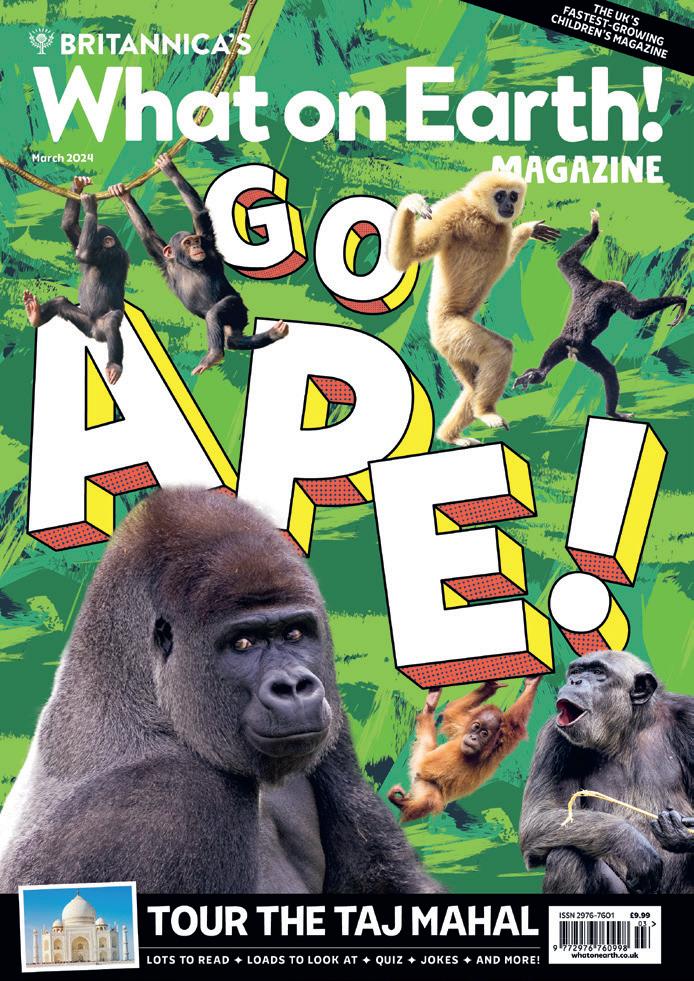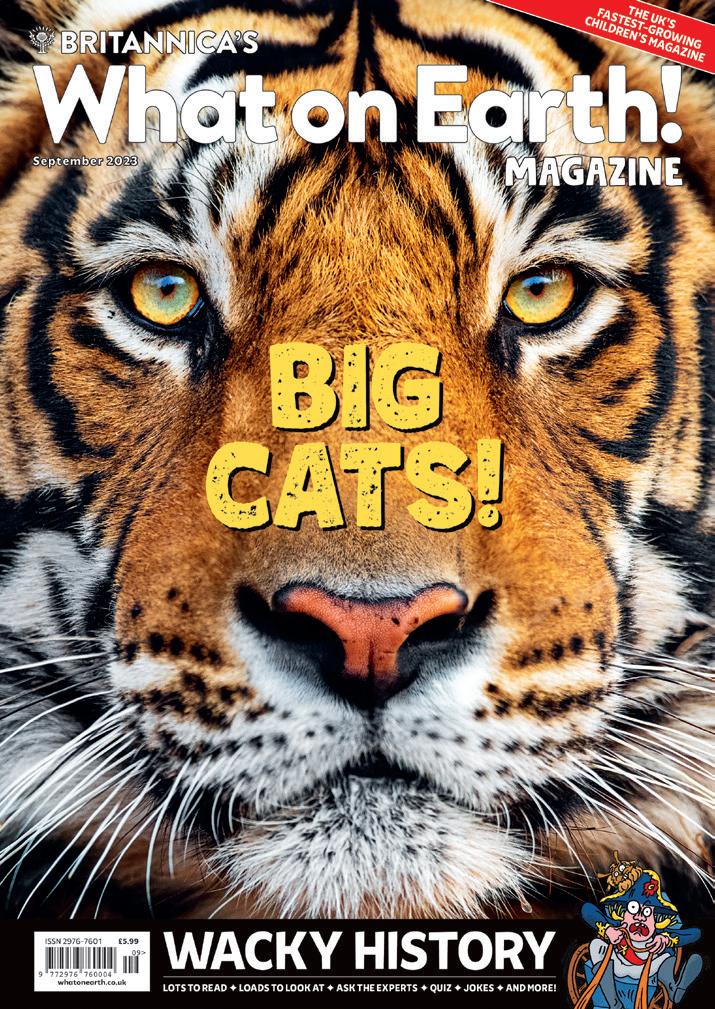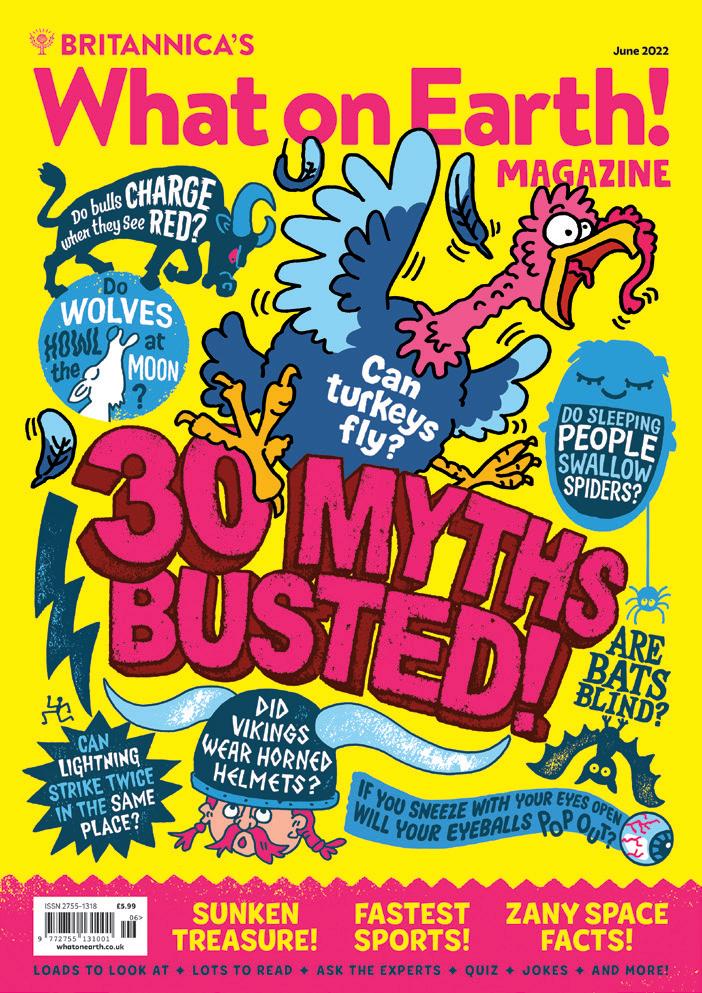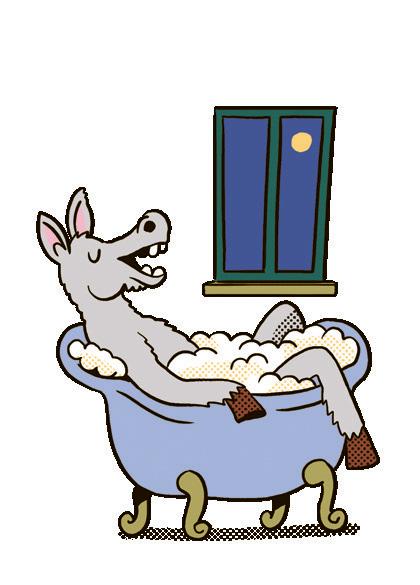

SPACE ROCKS
Learn about asteroids, meteoroids, comets and other mysterious space rocks on page 30.



Learn about asteroids, meteoroids, comets and other mysterious space rocks on page 30.

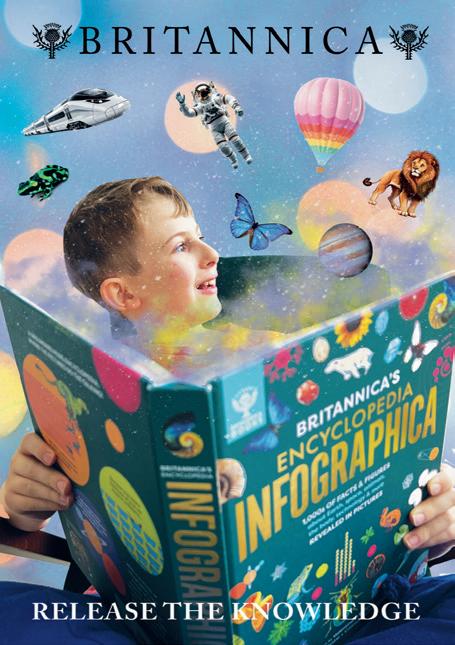
Check out our reader Reuben Colton’s brilliant Britannica-themed book poster on page 50.
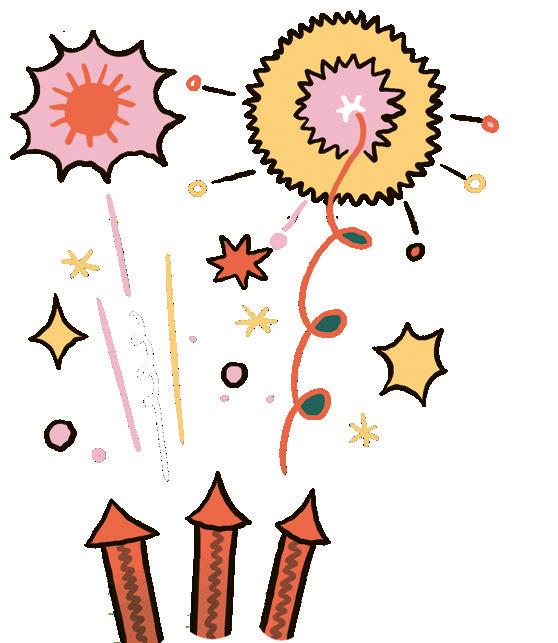
LISTIFIED!
Help What on Earth! Magazine celebrate our second birthday with these sweet birthdayrelated lists on page 44.
Follow the trail of crazily connected facts on page 4, all the way from a prehistoric giant parrot to a job chewing gum!

See if you can recognise the iconic board games that feature in our delightfully tricky picture quiz on page 25.
Exactly how many krill can a giant blue whale eat? Find out more about this massive and majestic animal on page 43.
EUREKA!
Catch up with the world’s first jet suit race on page 10 – plus, learn about a newly discovered underwater mountain!
Why do we laugh? Where do jokes come from? Explore the hilarious world of comedy on page 16

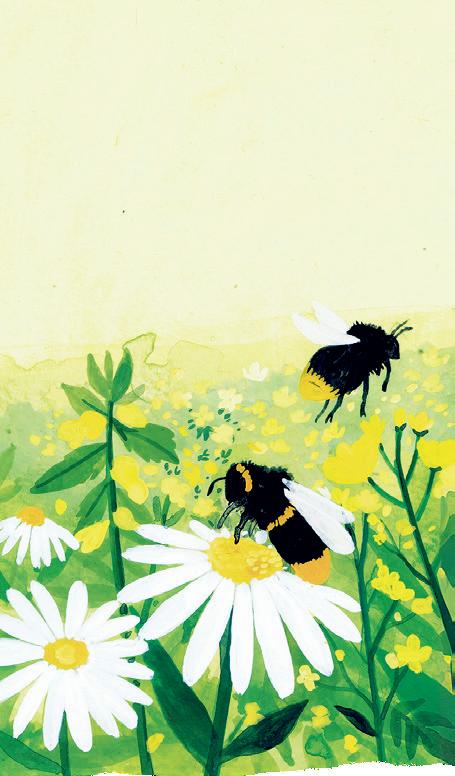
Find out how species evolve together to help each other to survive on page 38.


To win ALL the brilliant books featured in our April Issue, just answer this question:
How many Easter eggs, including the three shown below, can you find hidden inside this magazine?
Send your answer to editor@whatonearth.co.uk and a winner will be chosen at random by our jokes editor May.
Good luck!



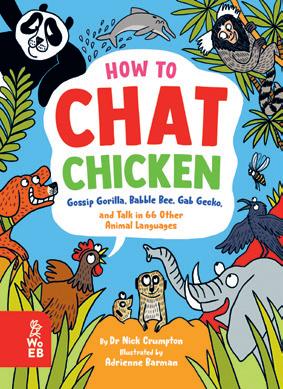
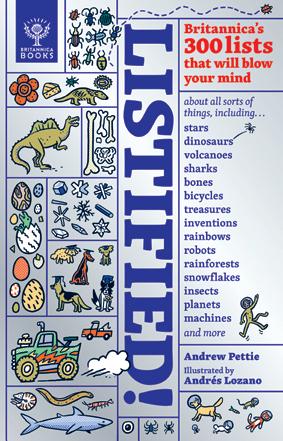
Say hello to this friendly bear and see some other stunning photographs on page 6
WORD UP!
Test your brain – and your tongue! – with some fun tongue-twisters on page 42. For a challenge, try some in other languages!
PUZZLES & GAMES
Page 34
THE WHAT ON EARTH! QUIZ
Page 46

Genghis Khan was one of the most powerful rulers of all time. Learn more about Genghis Khan and his massive Mongol Empire on page 48
Email us your letters, photos and favourite facts to: editor@whatonearth.co.uk


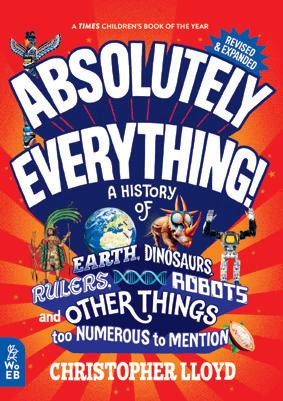
You can also find all these books (and more!) at whatonearthbooks.com/ shop

Follow the trail of crazily connected facts all the way from a giant parrot… to a job chewing gum!
By Kate Hale, Paige Towler, Julie Beer and Rose DavidsonIllustrations
by Andy Smith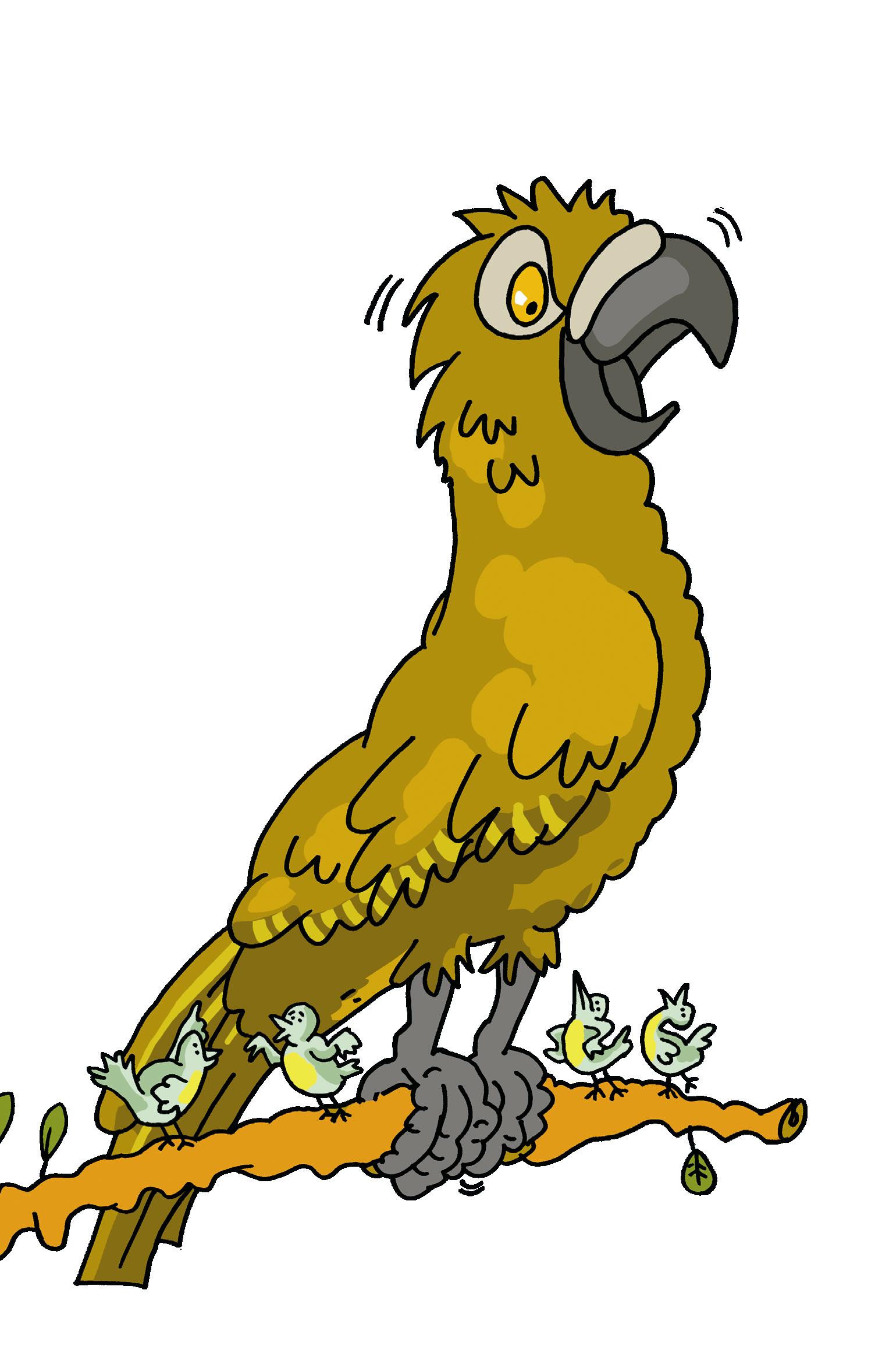
The fossil of an ancient bird discovered in Antarctica had a wingspan wider than the height of a two-storey building


Scientists discovered an ancient species of parrot as tall as a threeyear-old and nicknamed it
‘
squ a wkzilla’ ‘ squ a wkzilla’

A 16th-century Ottoman map appears to show Antarctica without any ice, which is how the continent probably looked 6,000 years ago
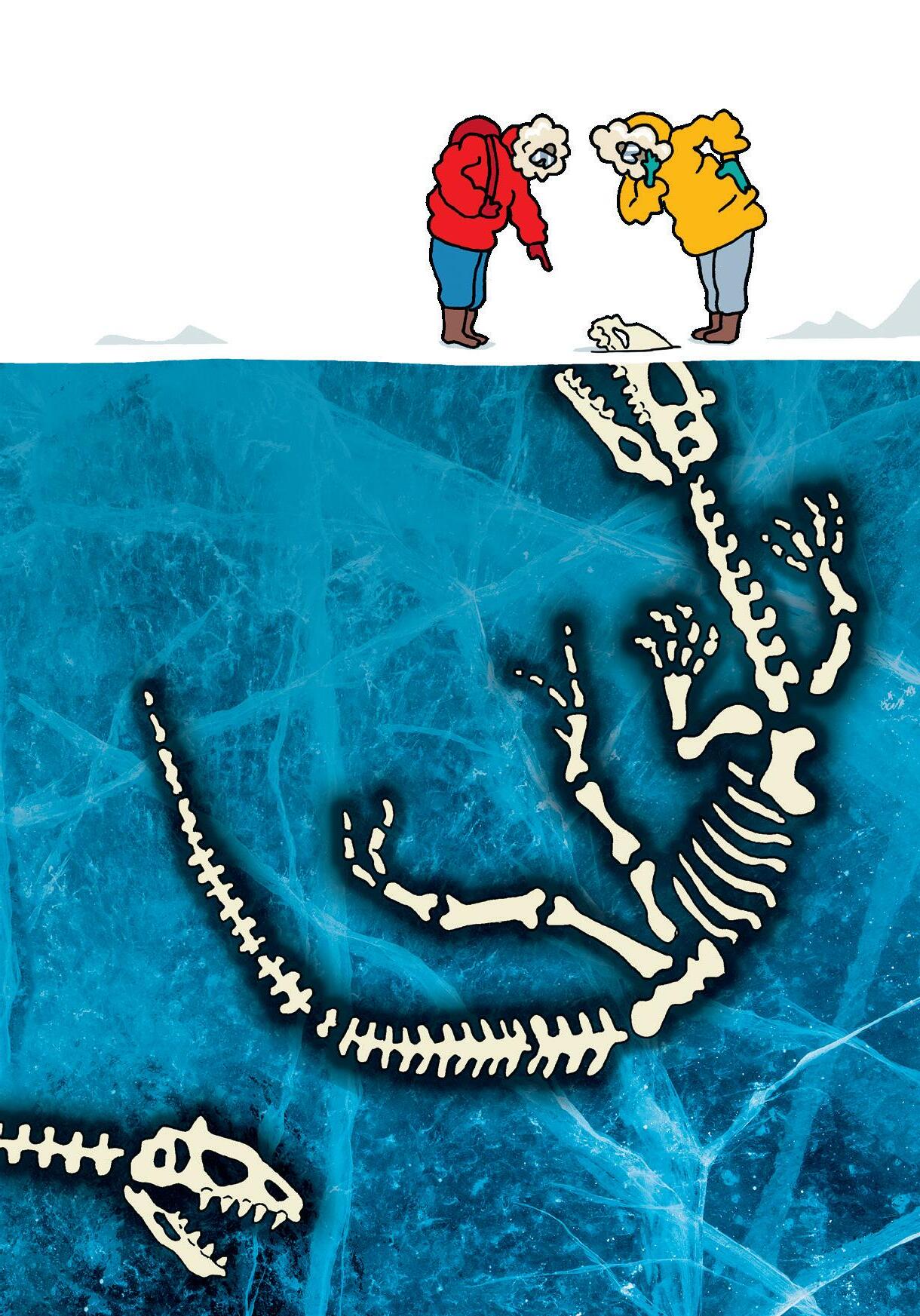
In1991,geologists discovered dinosaur fossilsunderthe ice in Antarctica
Prehistoric people drew star maps in the shapes of animals on the walls of caves in France

NASAhassentamapintospace to show extraterrestriallifehowtogetto


After an Unidentified Flying Object crashed in Roswell, New Mexico, USA, in 1947, people believed that the town had been visited by aliens – but it was actually secret government technology

AreportedUFOsighting in2004wasnicknamed ‘TicTac’becauseitwas apparentlyshaped likethesweet.
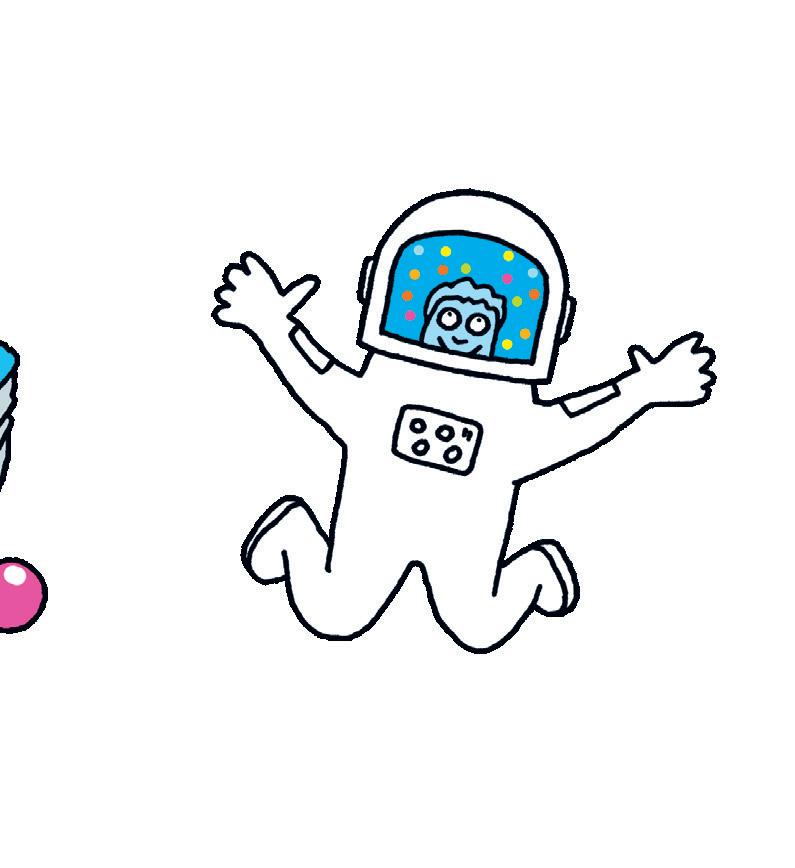
Archaeologists have found chewing gum that’s 5,700 years old




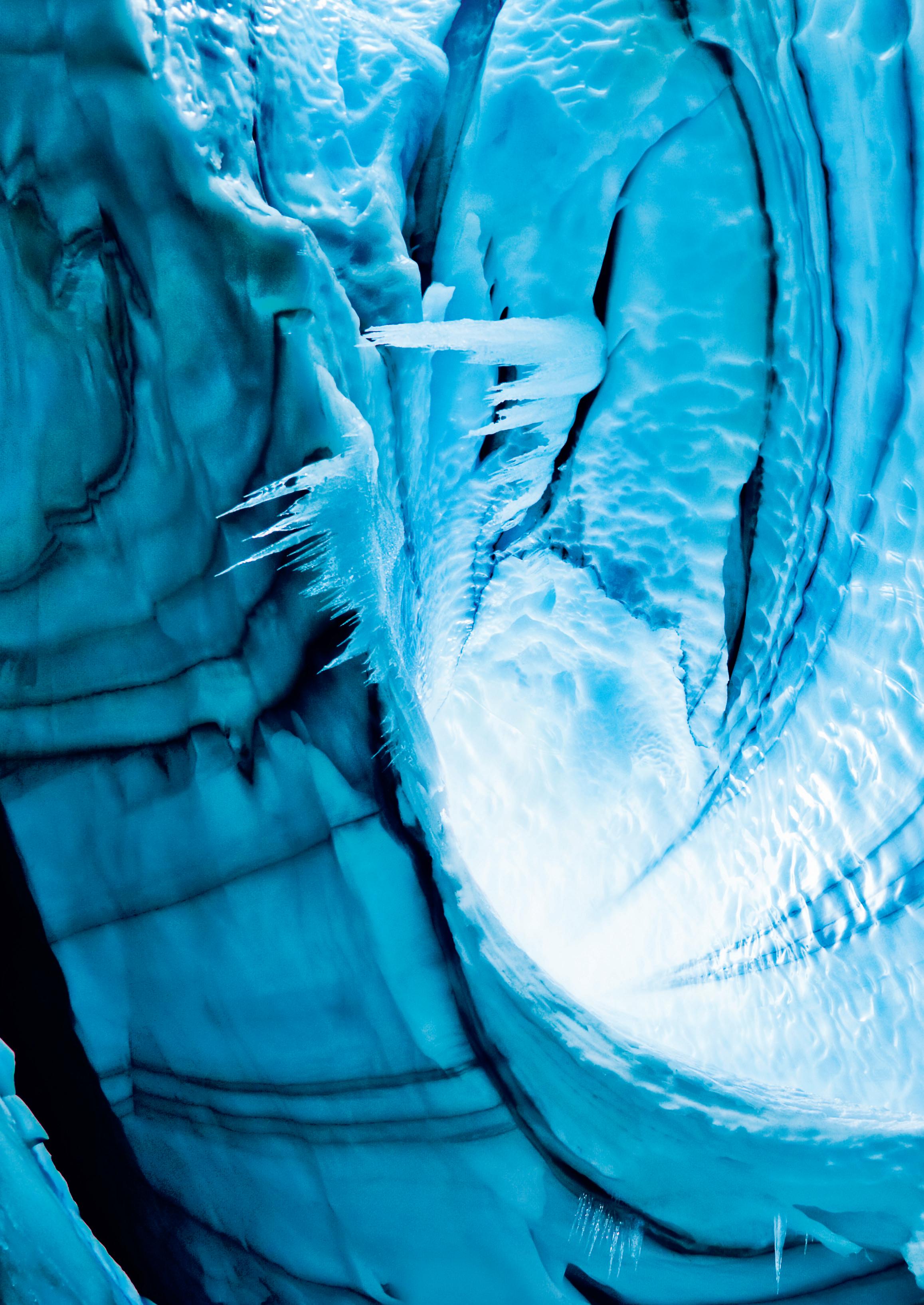
This ice climber is exploring a cave made of ice that is nearly 25 metres underneath Langjökull Glacier in Iceland. Ice caves like this one are formed by hot springs underneath glaciers or by meltwater that flows from the surface. Very cool!



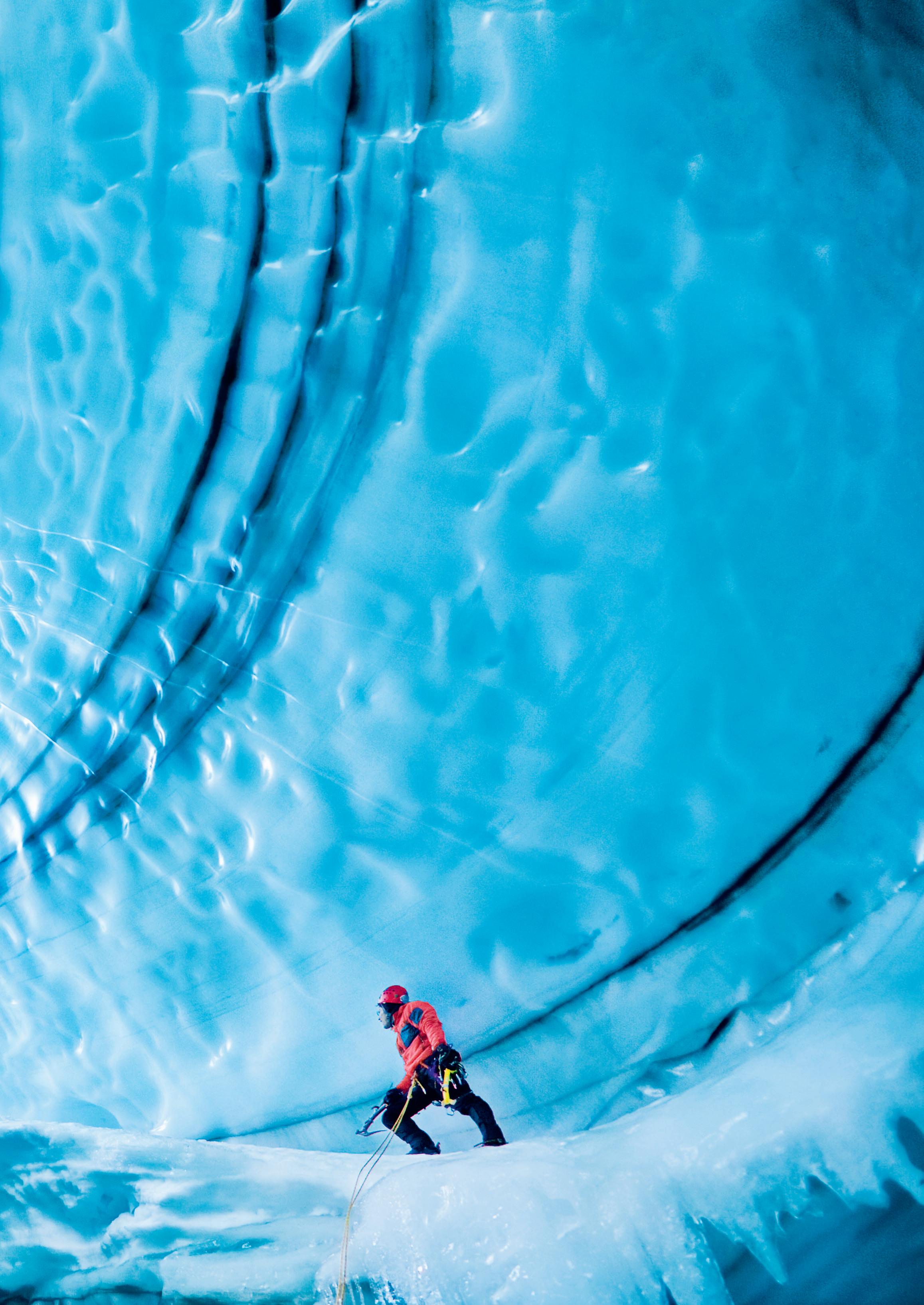



The Farleigh Dickinson Knights men’s basketball team from New Jersey, USA, seem to be floating in this fun photograph. While doing their warm-ups before a game, the team all jumped at the same time as the player on the right made a dunk, which was caught at exactly the right moment by the photographer.
SONY WORLD PHOTOGRAPHY

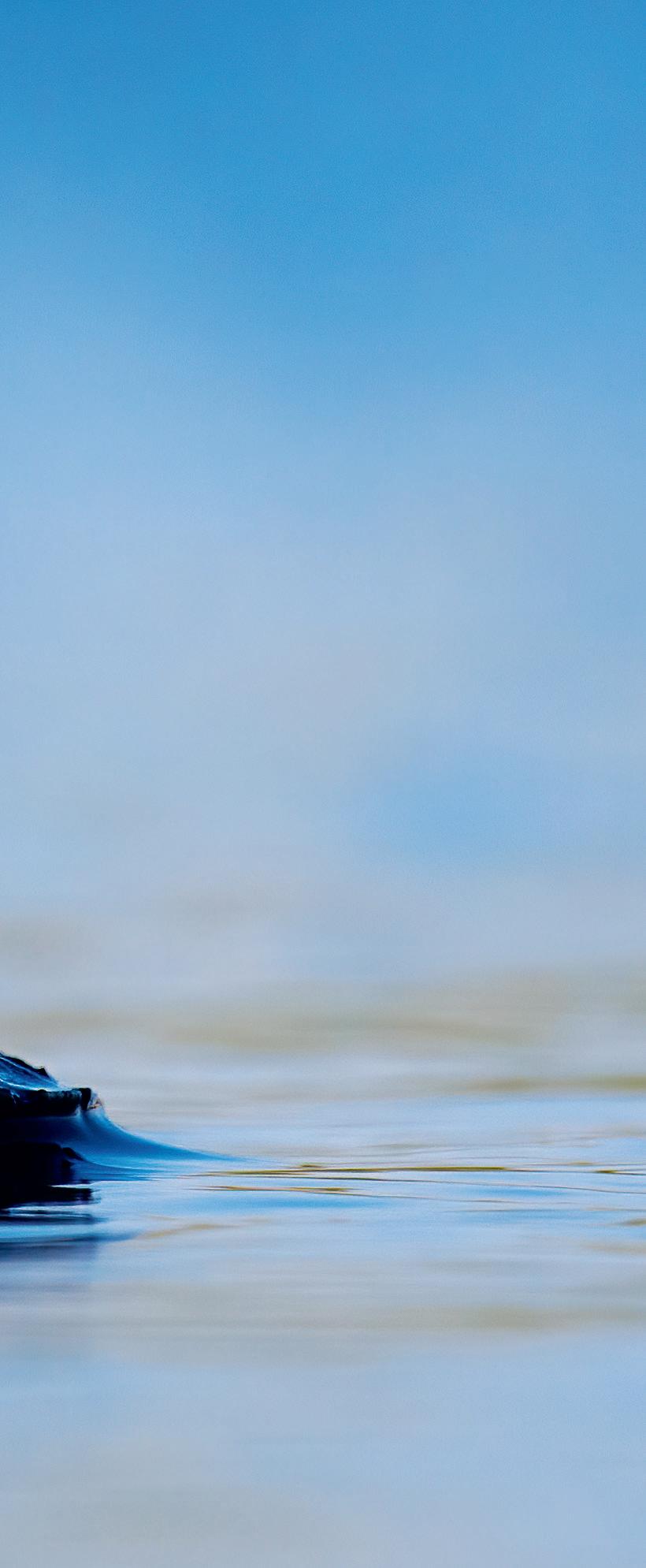


This sweet moment between a Balkan pond turtle and a northern banded groundling dragonfly was captured by a bird-watching photographer in Israel’s Jezreel Valley. Instead of snapping up the dragonfly as a nice snack, the turtle appears to be greeting it with a friendly smile!
COMEDY WILDLIFE PHOTOGRAPHY AWARDS 2023 / TZAHI FINKELSTEIN

As the Moon rose over the horizon, lights on flying drones lit up this rock formation in Scotland. Meanwhile, a blizzard was raging! The photographer had to be very quick to take the photo.




This brown bear in Finland is waving to get the attention of photographer Dikla Gabriely. Gabriely says the bear seemed to want the photographer to pay attention to him and not the other bears! At a massive 500 kilograms, brown bears are the largest land predator in Europe – but this one seems rather friendly, don’t you think?
COMEDY WILDLIFE PHOTOGRAPHY AWARDS 2023 / DIKLA GABRIELY



The latest astonishing discoveries, inventions and scientific breakthroughs.
A huge underwater mountain has been found by scientists exploring off the coast of Chile in South America. Perhaps even more excitingly, the mountain is thought to be home to more than 100 previously unknown species of sea life.
Much of the deep ocean is still unexplored. The water pressure there is very high and there is no sunlight. Scientists were able to discover the underwater mountain they are calling Solito, and three other ‘seamounts’, using a special robot that could explore up to 4,500 metres below sea level. They were exploring the Salas y Gómez Ridge, which is an underwater mountain range stretching between Chile and Easter Island. So far the scientists have found new deep-sea corals, lobsters, squid, urchins and other strange animals. They hope that more exciting discoveries will be made soon.
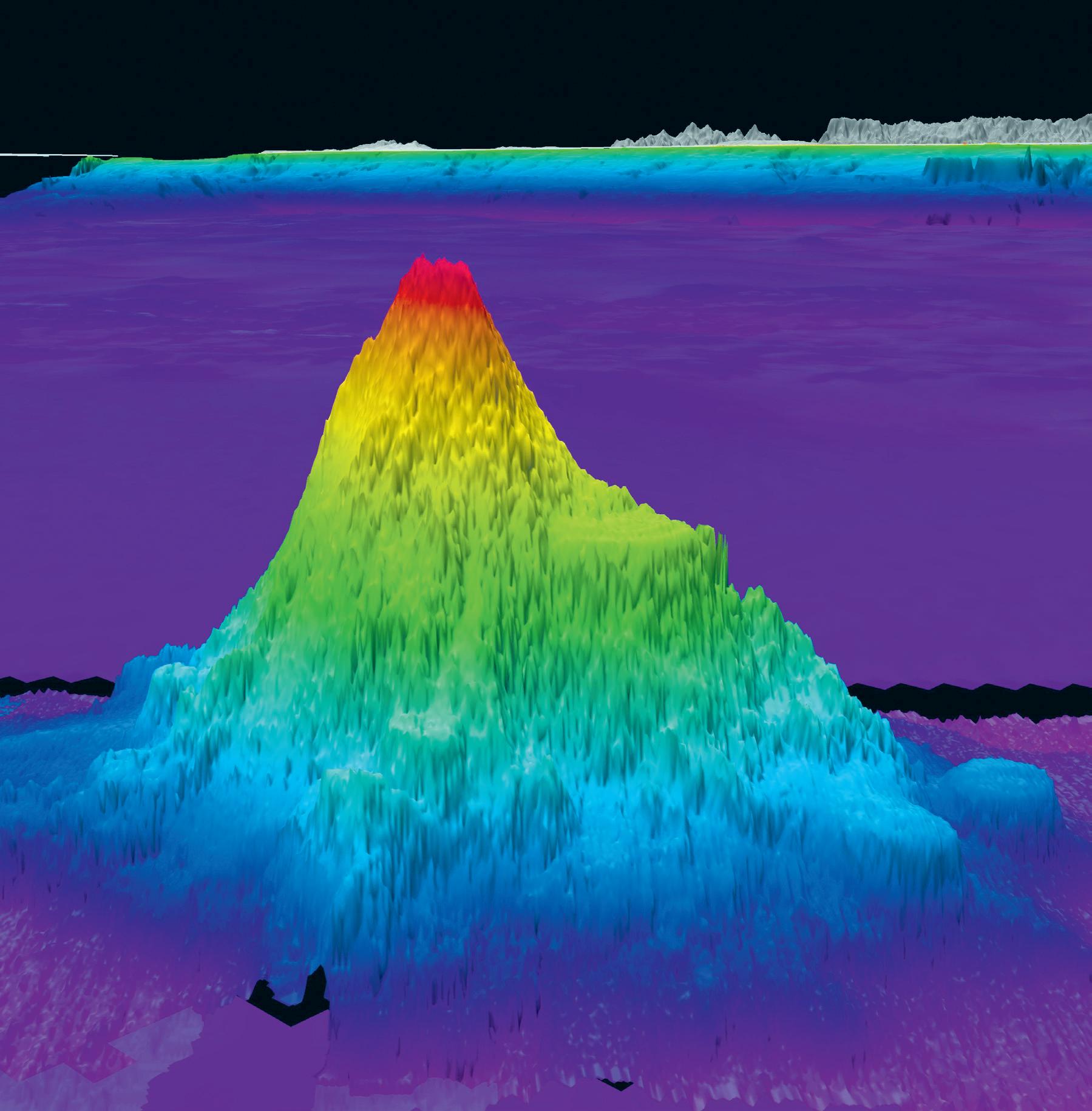
Scientists in Brazil have discovered that the so-called flea toad (which is actually a species of frog) may be the world’s smallest vertebrate animal. This tiny frog is only about the size of a pea, with an average length of about 7 millimetres. The males of the species are slightly smaller than the females.
The current record holder for tiniest vertebrate is also a frog, Paedophryne amauensis, which is found in Papua New

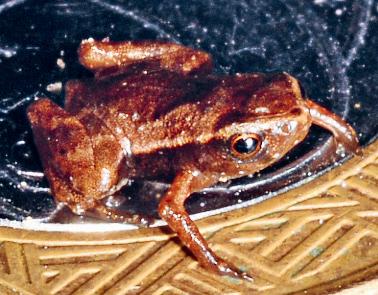
Guinea. A scientist named Mirco Solé and his team wondered if the flea toad might be even smaller. Before their research, only a few flea toads had been found. They are only known to live on two forested hilltops in southern Brazil. Solé’s team measured 46 adult frogs to see what their average length was. The smallest adult male frog they measured was only 6.45 millimetres long. Yet scientists think that even smaller frogs may well exist!
The underwater mountain called Solito is a staggering 3,530 metres tall, which is more than four times taller than the world’s tallest building, the Burj Khalifa!
 The frog at actual size (right) and enlarged (below).
SOLITO 3,530 metres
SEA LEVEL
The frog at actual size (right) and enlarged (below).
SOLITO 3,530 metres
SEA LEVEL



An exciting new kind of race took place in Dubai in the United Arab Emirates in February – a jet suit race!
Seven racers wore suits that somewhat resemble those worn by the Marvel hero Iron Man. The suits, which are powered by the same fuel as aeroplanes and have more
powerful engines than most sports cars, allowed the racers to zoom around at speeds of up to 130 kilometres per hour! They raced around a water channel in Dubai’s marina and flew around obstacles which had been placed in the water.

There was one crash during the race, when a pilot splashed down into the water. He was rescued by a boat and gave a thumbs-up to the crowd of spectators.
Dubai is a city known for its innovations. Flying taxis could be next on the list!

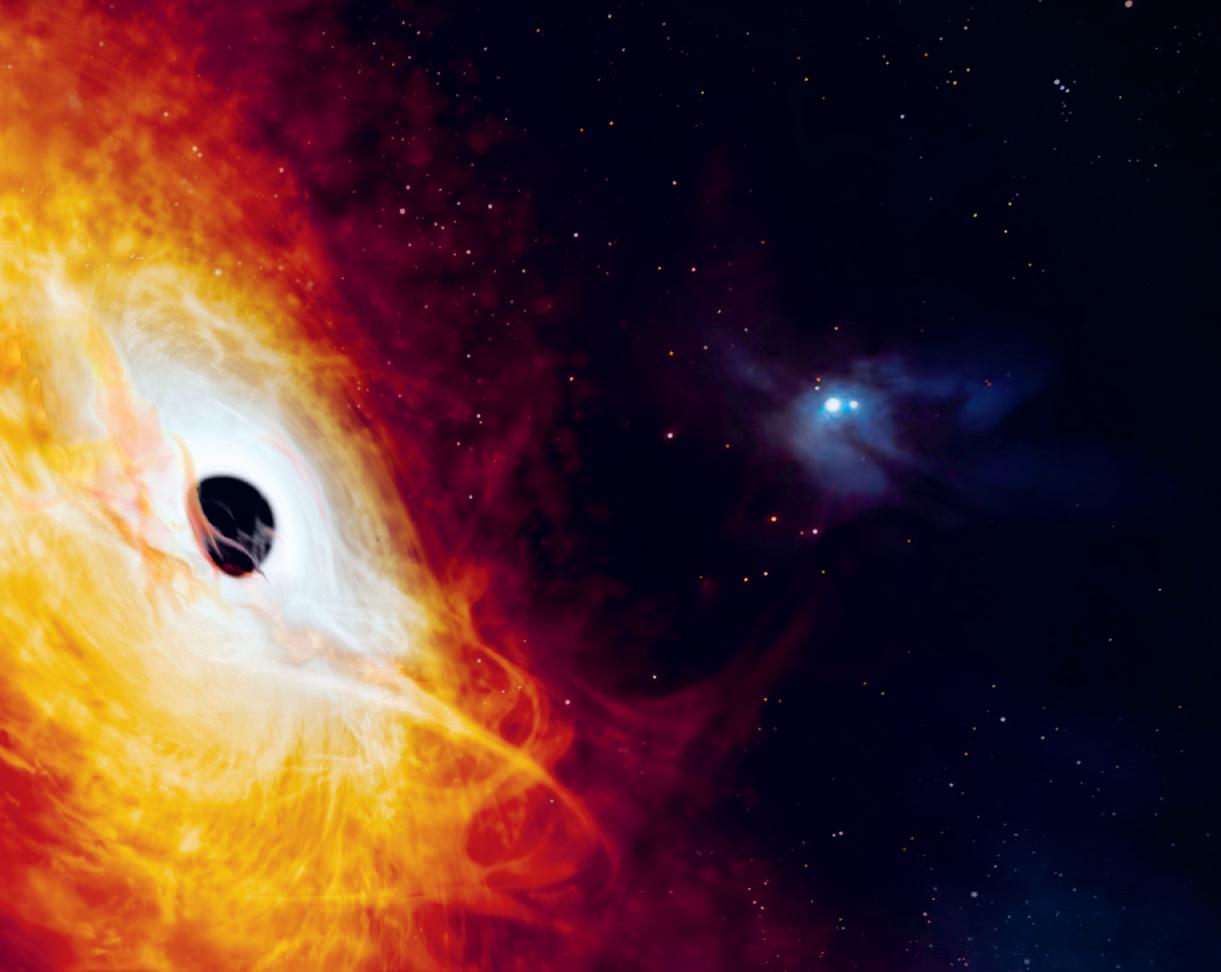
An artist’s illustration of quasar J0529-4351 and its giant black hole.
Jet suit racers fly around obstacles in Dubai.
Let there be light! Astronomers discover brightest object in the known universe
Using the Very Large Telescope in Chile, astronomers have identified the most luminous object in the known universe. Luminosity is a measure of how bright something is at its surface, rather than how bright it appears to us on Earth. The dazzlingly bright object is a quasar, the core of a galaxy that is powered by a black hole. The black hole sucks up material around it, making the quasar appear even brighter.
The quasar, called J05294351, is about 17 billion times as massive as our Sun. And it is as bright as 500 trillion Suns. Its black hole devours the mass of a Sun every day and is growing at an astonishing rate.
At first, scientists did not recognise that J0529-4351 was especially luminous. They thought it looked so bright because it was near to Earth. In reality, its light has taken some 12 billion years to reach us!



Humans can gather information from the words that they use when they talk. But they can also get extra information about how someone might be feeling from how they are talking. Amazingly, this is something that humans and goats have in common!
Goats can recognise the differences in other goats’ bleats (even if they might sound the same to humans). To test this, scientists played the sounds of goats enjoying a treat to other goats.
They found that the listening goats had increased heart rates. When they heard sad goats (who were recorded when they weren’t allowed food) their heart rates stayed normal.
For a long time scientists thought that being able to read and understand the emotions of other animals was something that only primates such as humans and monkeys and a few other animals could do. To find this ability in goats was quite a surprise! So maybe think twice next time you gossip with a goat – they might be understanding more than you think!


(This is delicious!)
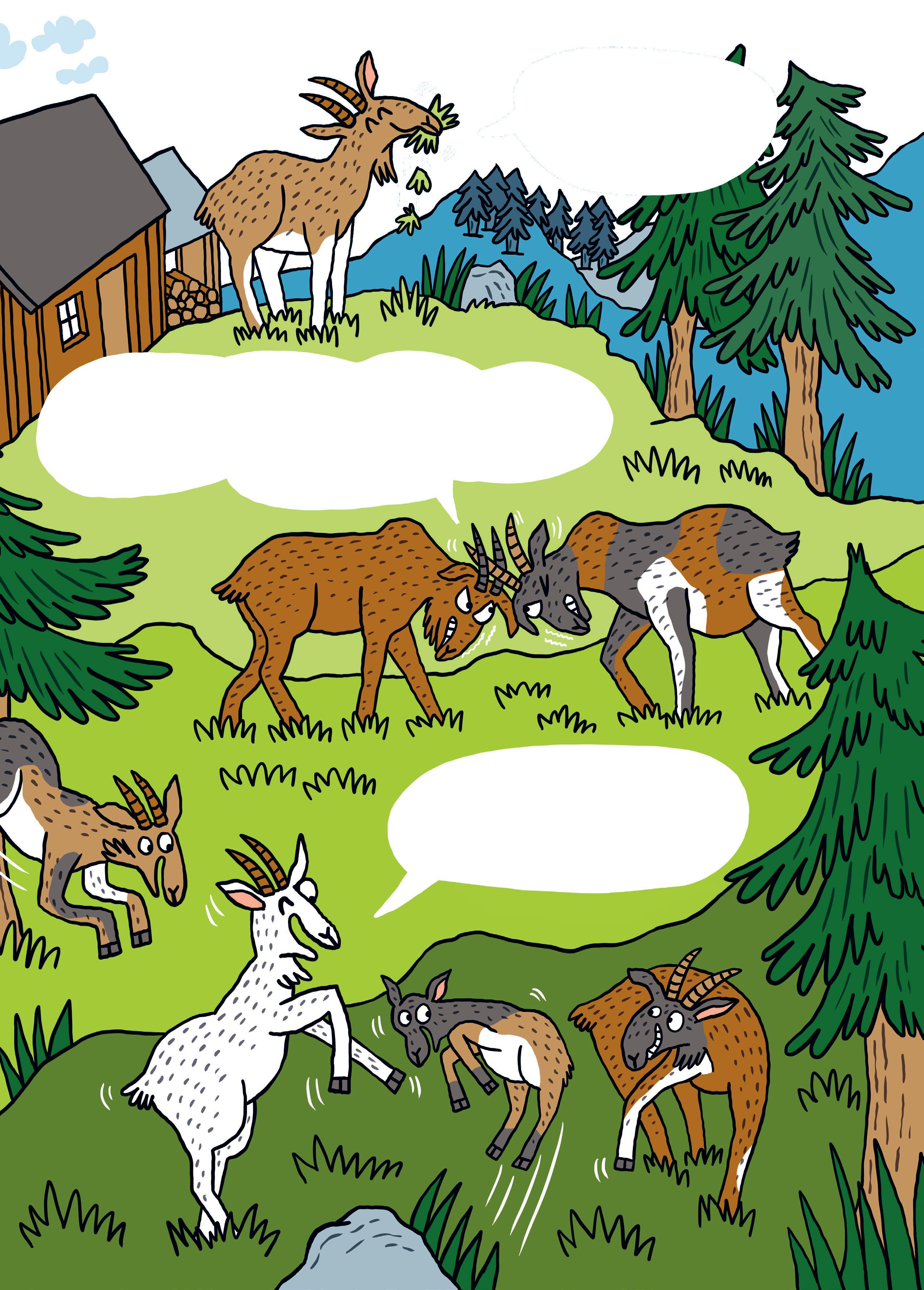
(I’m angry )
MA - A H - AH
(Let’s play!)



Pigs and their relatives, such as wild hogs, peccaries and babirusas, are very social and intelligent animals. They make nasal, throaty calls to keep in contact with other pigs.
(Everything is A-okay!)
We want to hear your best farm animal impressions! Record yourself making the goat or pig noises listed here and email the file to editor@whatonearth.co.uk
The best impressionist will win a copy of the new book HowtoChatChicken!

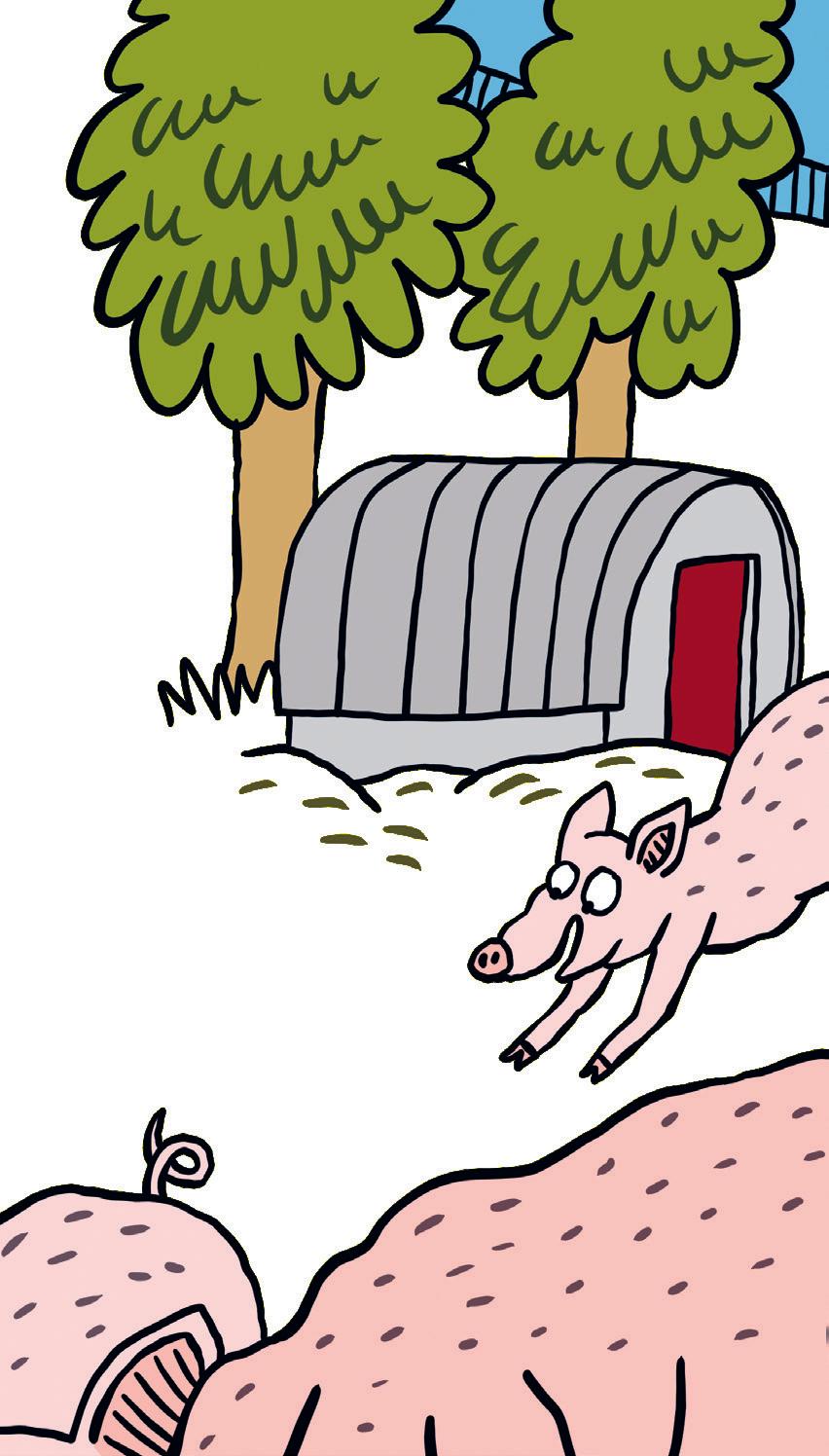


Pigs grunt to let other pigs know that they are there and everything’s okay. They normally make this noise as they are going about their daily business.
A longer grunt is similar to a cat’s purr and means they are relaxed. Female pigs make this noise when they are suckling their piglets.
(This is relaxing.)

(What was that?)
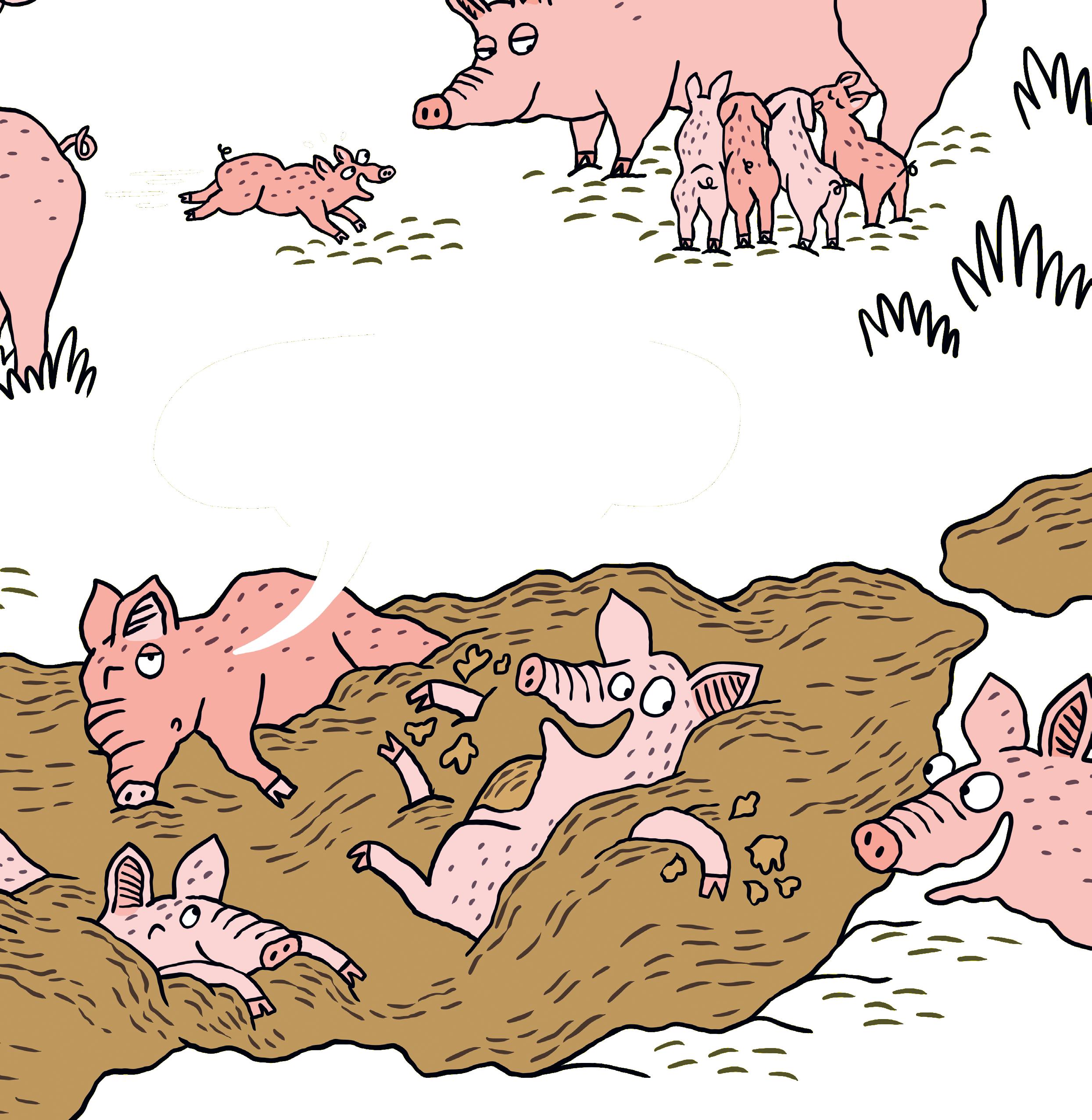
Pigs often bark when they’re playing or when they are startled.
do weSet off on a highly amusing adventure, as we explore the history and science of comedy. (With lots of funny jokes, plus a 2,000-year-old riddle, to tickle your ribs along the way!)
Illustrations by Andy SmithLaughter is a universal human experience. People from all known cultures laugh and smile. In fact, babies don’t even need to have seen or heard somebody else laugh to know how to do it. Laughter just comes naturally.
So if laughing and smiling is such an important and instinctive part of what it means to be human, why have we evolved to do it? Here are three good reasons:
1 Laughter helps form social connections. People laugh more often when they are with other people. In fact, scientific studies have shown that you are 30 times more likely to laugh if you are with
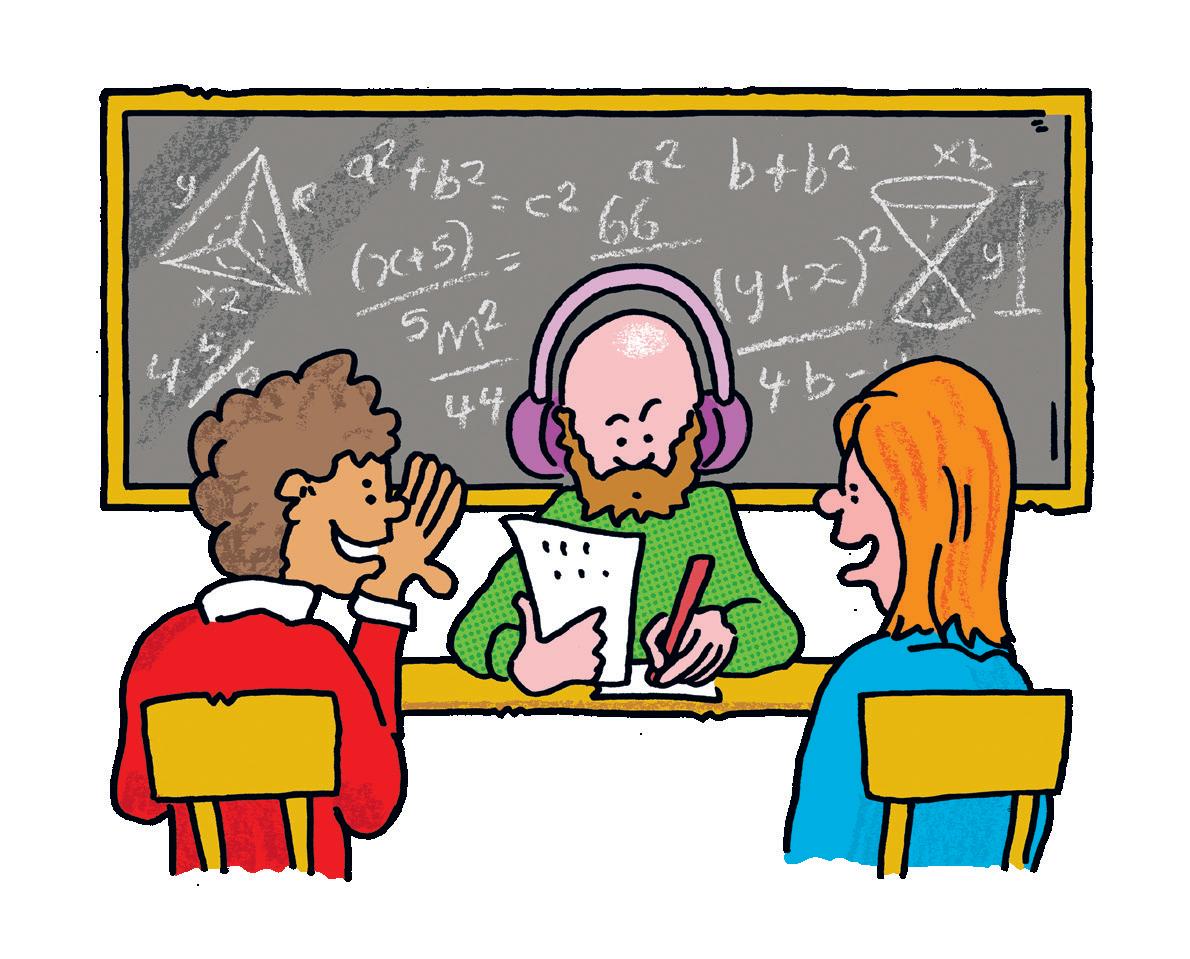
Anything you like!
someone else than if you are alone. Like yawning, laughter can be contagious: once you see other people laughing you sometimes can’t help but join in. Laughing with other people creates social bonds around shared moments of joy.
2 Because we’re being tickled! Scientists don’t fully understand the evolutionary reasons why being tickled makes us laugh but they do know there’s nothing we can do about it! It’s an automatic physical response.
3Laughter is good for us. When we laugh, levels of a stress hormone in the body called cortisol go down. At the same time, levels of adrenaline and endorphins, which are hormones that make us happier and more relaxed, go up. Studies also show that laughter stimulates the heart, boosts the immune system and can help people to cope with physical and emotional pain. So maybe laughter really is the best medicine!

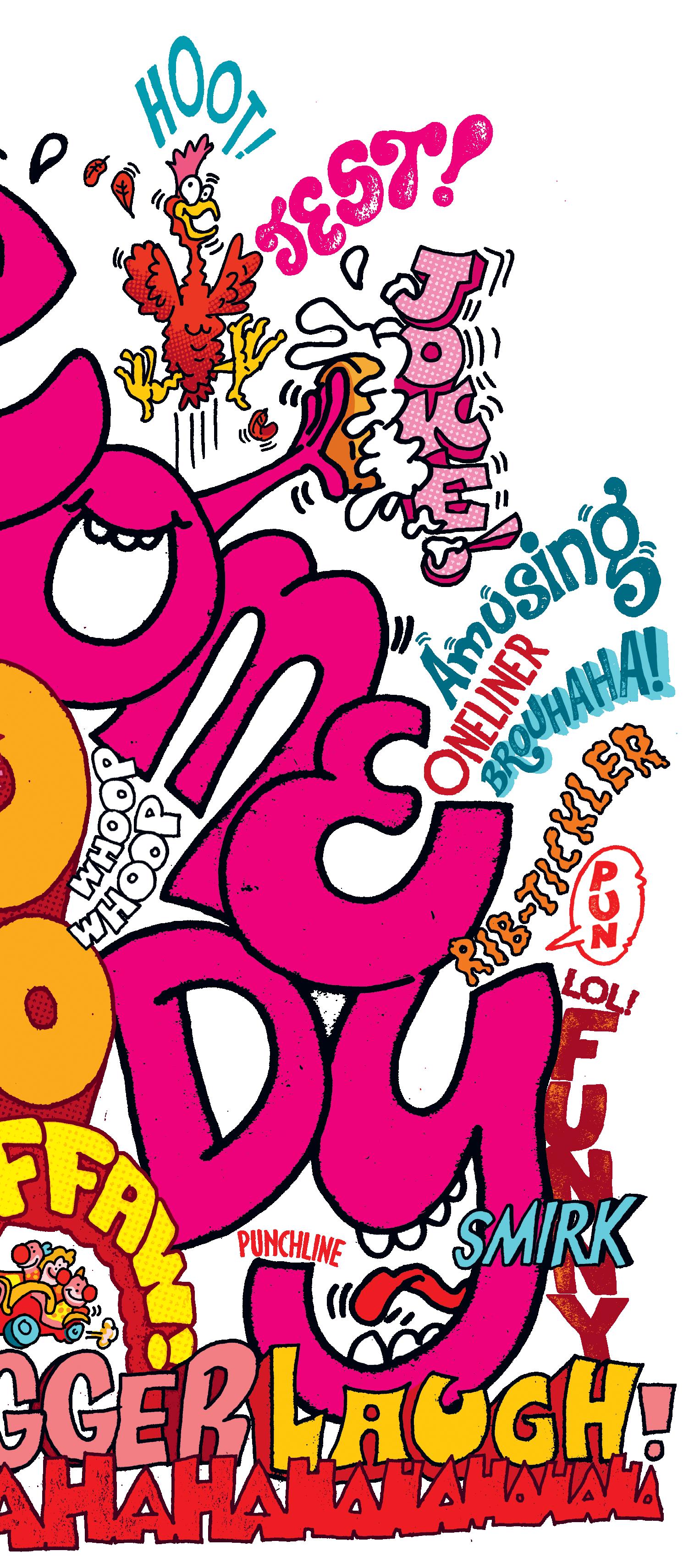
Lots of jokes rely on a pun, which is a humorous play on words. To create their comic effect, puns often rely on words that sound the same or similar to each other but have different meanings. Sometimes puns use homographs, which are words that are spelt the same but have different meanings. Here is an example:

Q: How do you make a sausage roll?
A: Push it down a hill!
The humour in this joke relies on the fact that the word roll could mean two different things: a roll you can eat, or to roll something down a hill.
Other puns rely on homophones. These are words that sound the
same or similar to other words but are spelt differently and mean different things. Here is an example:
Q: Who was the most cowardly knight at King Arthur’s court?
A: Sir Render!
In this joke, the name of the cowardly knight, Sir Render, sounds the same as the word surrender.
Not all puns involve wordplay, however. Some puns are visual, like the picture of the cherry pie below.
As you can see, the pie has been made with the symbol for the mathematical ratio Pi on top.
So it’s a Pi pie!

Knock, knock. When someone sets up this type of joke it is almost impossible not to say or think in response: ‘Who’s there?’ Knock knock jokes are popular all around the world, and are told in lots of countries including the UK (obviously!), France, the Philippines and India. But how and when were knock knock jokes invented?
Historians cannot be sure who told the very first knock knock joke. But there are two interesting theories about how they began. Some experts think knock knock jokes started in the Middle Ages as repeated ‘call and response’ conversations used by castle guards. When people approached a medieval castle at night, they would have to shout out to the guards to ask to be let in.
wanted to be let into the castle after dark. Sometimes the castle guards or visitors will have made jokes or teased each other while asking and answering these formulaic questions, which might have been the inspiration for the first knock knock jokes.
Other historians of comedy trace the knock knock joke back to the famous 17thcentury English playwright William Shakespeare. In Act 2, Scene 3 of Macbeth, a play written by Shakespeare which was first performed in 1606, a minor character pretends to be a gatekeeper and says ‘Knock, knock! Who’s there?’ several times – although the scene of the play isn’t intended to be funny.
From medieval castle guards to a famous play by William Shakespeare, we investigate the mysterious origins of a favourite type of joke…
The castle guards would then call out: ‘Who’s there?’ And then a question and answer conversation would start, as the guards asked the visitors who they were, where they had come from and why they
Knock, knock. Who’s there?
Luke.
Luke who?
Luke out of the window and you’ll see!
Indeed, it wasn’t until the early 20th century that knock knock jokes as we know them today caught on. By the 1930s, they were everywhere: people held knock knock joke contests, and they were even worked into the lyrics of popular songs! Why don’t you try making up a knock knock joke of your own?
Knock, knock. Who’s there?
Isabelle.
Isabelle who?
Isabelle broken?
I had to knock!
Knock, knock. Who’s there?
Wanda.
Wanda who?
Wanda hear another knock knock joke?!
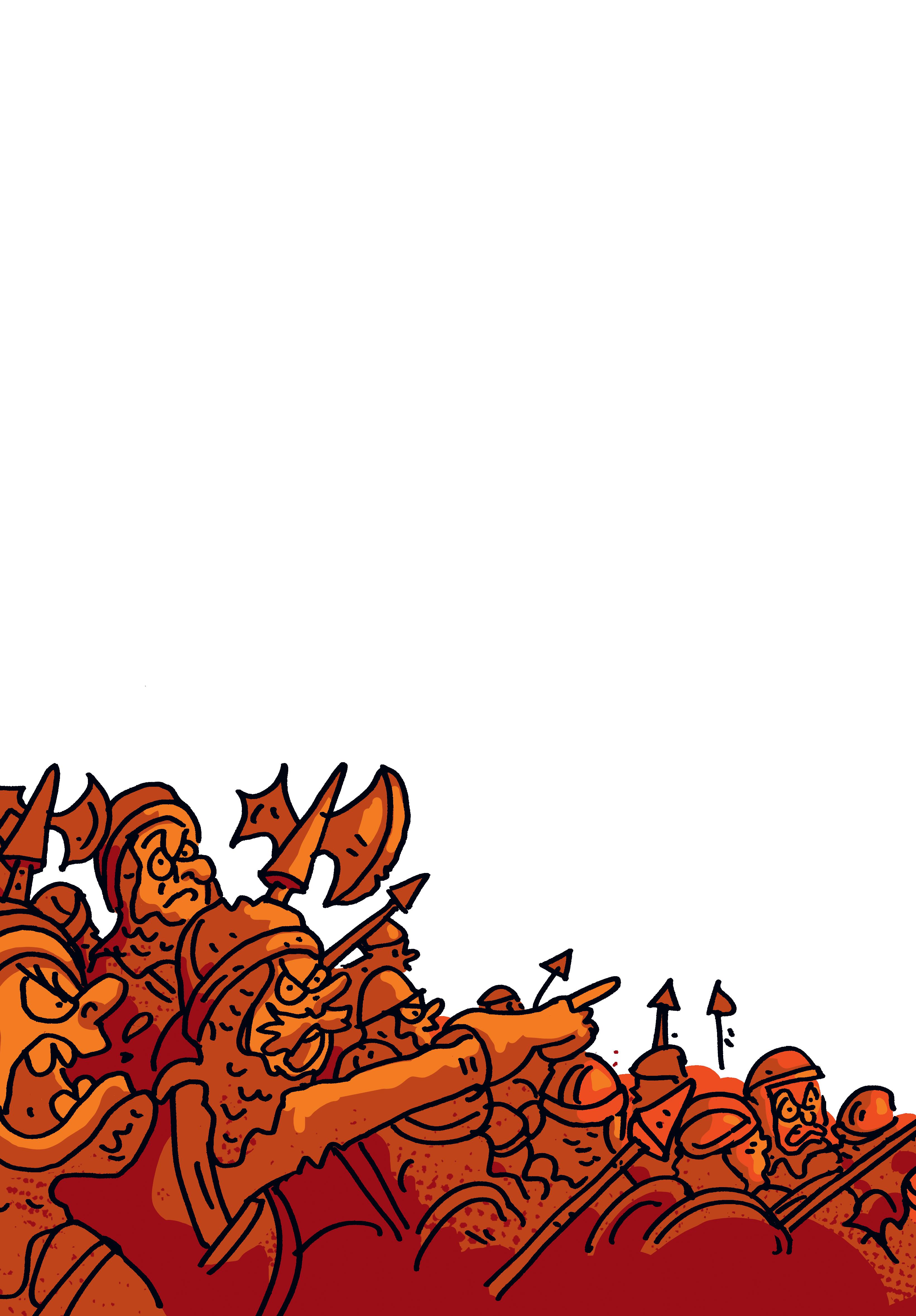

It’s an ancient riddle and one that is seemingly impossible to solve. You need a chicken to lay an egg. So you might think that the chicken must come first. Then again, chickens hatch from eggs. So perhaps the egg is the winner. This circular argument is what makes it such a popular riddle, and one that people have
How do chickens keep fit? They eggs-ercise!
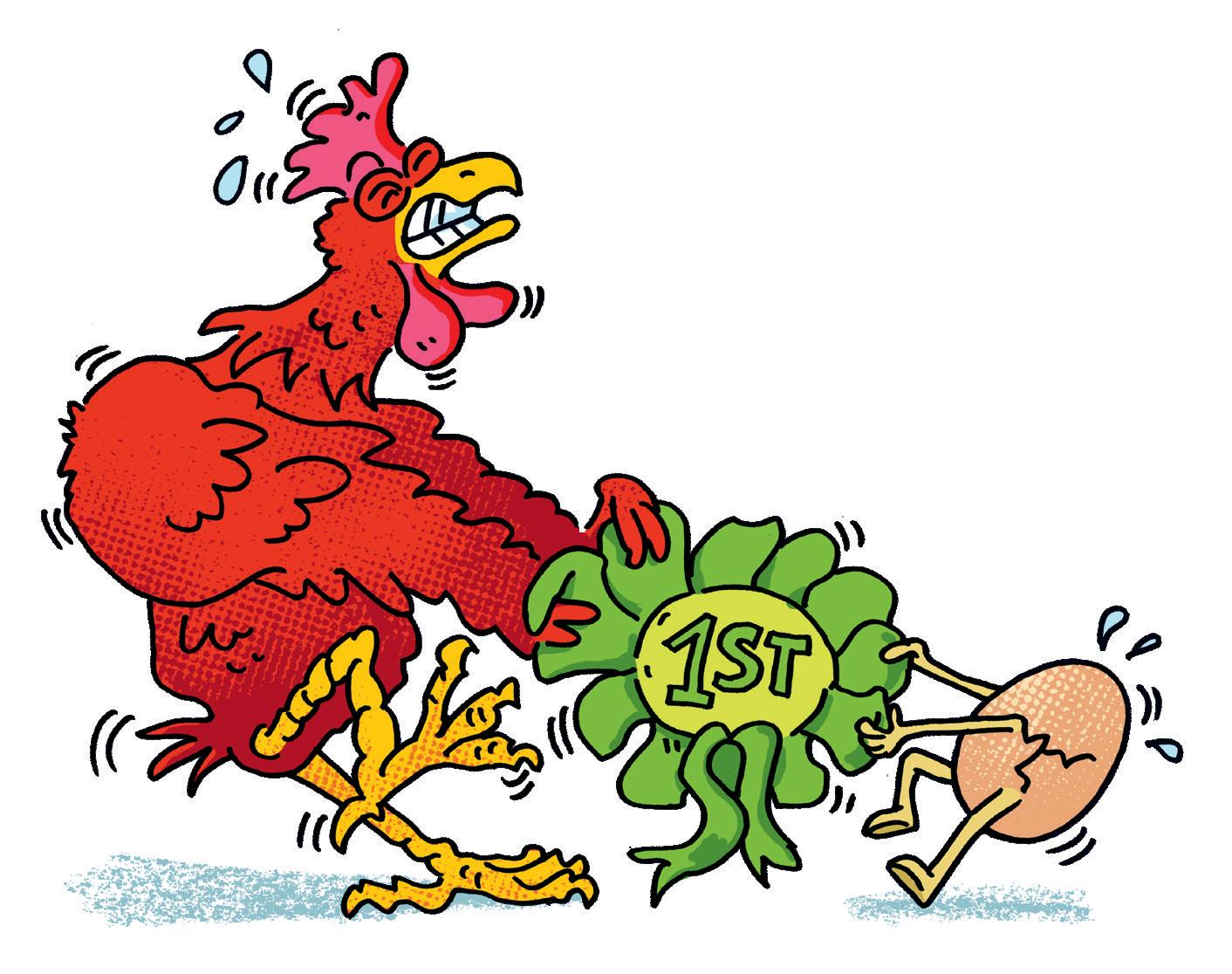
Knock, knock. Who’s there?
Anita.
Anita who?
Anita key to open the door!
Knock, knock.
Who’s there?
Alex.
Alex who?
Alex-plain later!
Knock, knock. Who’s there?
Impatient cow. Impatient cow wh—? Mooooo!
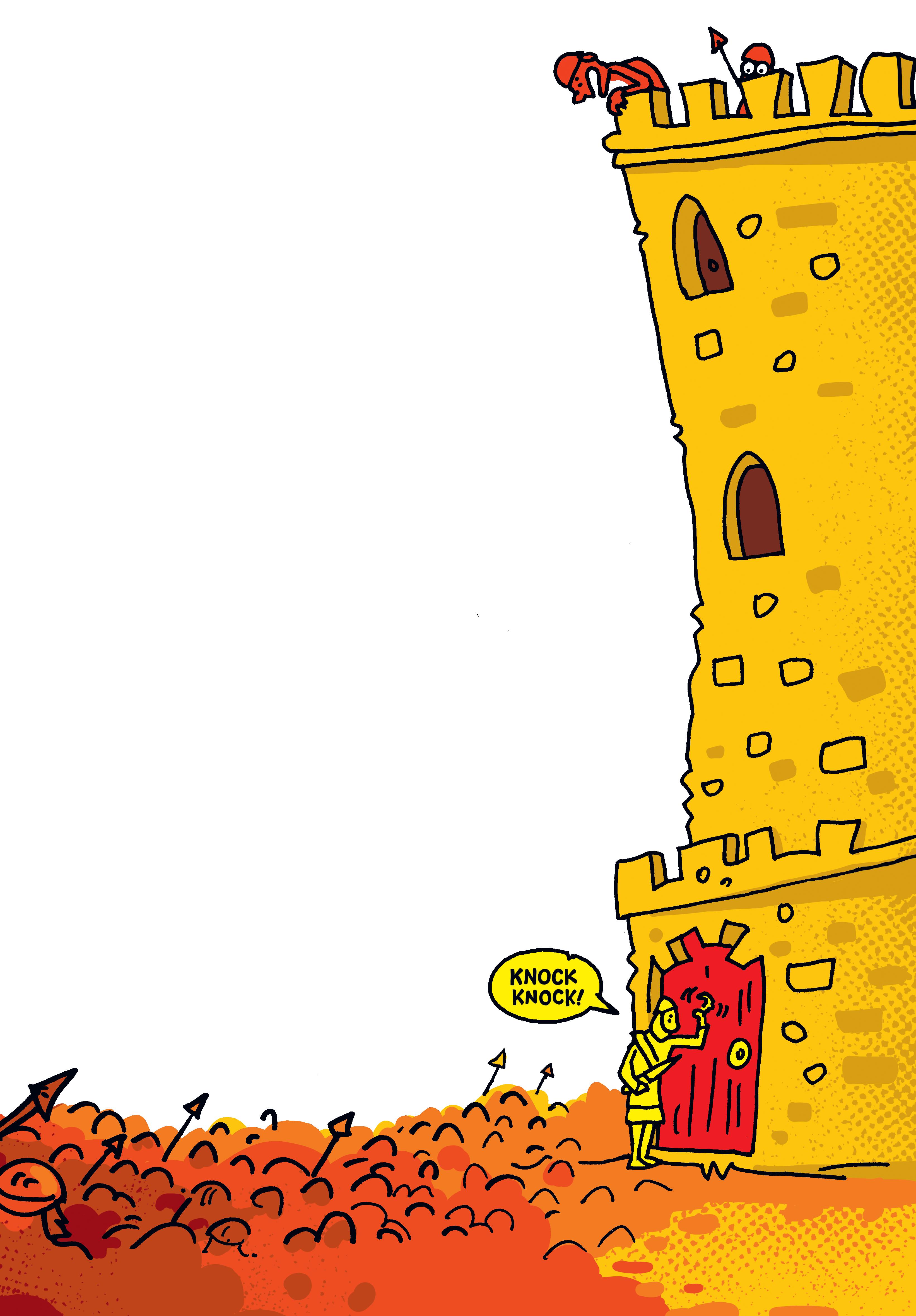
been debating for thousands of years. Did you know, for example, that the Greek philosopher Plutarch discussed the chicken versus egg riddle in an essay
he wrote in around 100 CE? Thankfully, modern science can provide some answers. Recent studies suggest that the first domestic chickens evolved from a species of bird called red junglefowl around 8,000 years ago. That sounds pretty old – but is nothing compared to the ancient egg! The first hardshelled eggs that could be laid on land appeared on Earth around 300 million years ago, which is before the dinosaurs! So on that basis, you could say that the egg came first. (Sorry, chickens.)

Knock, knock. Who’s there?
Sadie.
Sadie who?
Sadie magic word and I’ll come in!
Knock, knock. Who’s there?
Mia.
Mia who?
Mia fingers hurt from so much knocking!
Knock, knock. Who’s there?
Scott.
Scott who?
Scott nothing to do with you!
Knock, knock. Who’s there?
Gwen.
Gwen who?
Gwen do you think you’ll get around to opening the castle door?!
It is very hard to say with certainty whether animals are capable of making jokes and finding things funny in a similar way to humans. However, several scientific research studies suggest that some animals do enjoy playing together, teasing one another and being tickled. Here are some fascinating examples of what having a sense of humour might look like in the animal kingdom…
Great apes

Scientists have observed chimpanzees, bonobos, orangutans and gorillas –which are human beings’ closest relatives – teasing members of their own species. This teasing behaviour includes poking, hitting and, in the case of orangutans,
pulling each other’s hair. One famous and funny example is Koko, a western lowland gorilla who was taught 1,000 American Sign Language signs and 2,000 spoken English words. Like the puns on page 17, Koko was able to play with different meanings of the same word while communicating with humans. She also played practical jokes on her trainer. For example, she once tied the trainer’s shoelaces together and then signed the word ‘chase’ to encourage the trainer to run after her – and then trip over in the process! Great apes also produce laughter-like sounds when they are tickled.
Elephants
Elephants sometimes trumpet with excitement while playing together.

Dogs
When dogs are playing, they can produce a breathy snort which sounds a bit like a doggy version of laughter. One expert in animal behaviour played a recording of this snorting sound to other dogs and found that it lowered their stress levels.
Parrots
Some parrots have been observed teasing other animals, seemingly just for fun. For example, by whistling at a family’s pet dog apparently just to confuse it!
Dolphins
Dolphins produce high-pitched squeaks of apparent joy while they are play fighting with each other.
Rats
When people tickle rats or rats engage in rough and tumble play with other rats, they make joyful squeaks that are similar to giggles (though they are too high-pitched for humans to hear). According to studies, rats enjoy the feeling of being tickled and can even be taught to play hide-and-seek in order to receive a ‘tickling reward’!

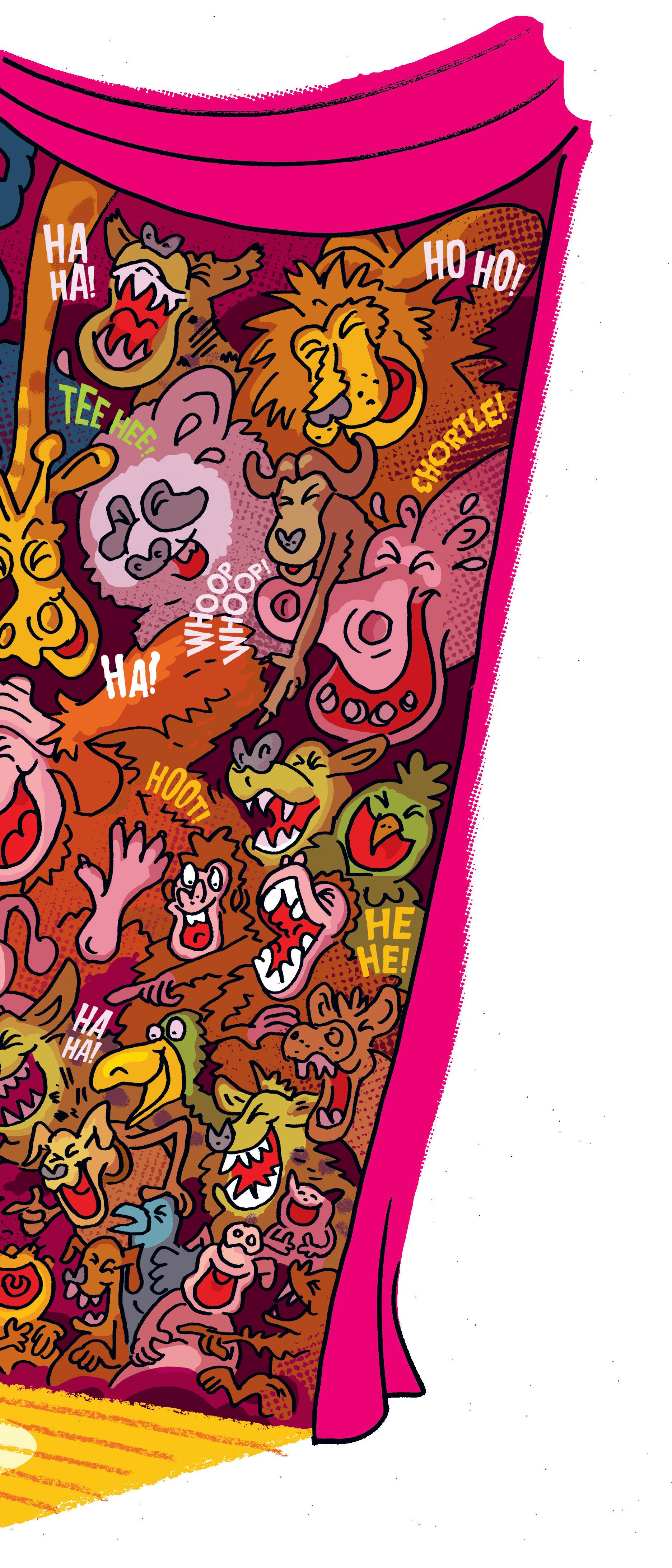
What do you call two spiders that have just got married?

Why are penguins brilliant racing car drivers?
They’re always in pole position!
How do chickens remember to wake up? By setting an alarm cluck!
Which type of insect is always modest? A humble-bee!
How do you stop an elephant charging? Unplug its iPad!
How do hedgehogs play leapfrog? Carefully!
What do you call a dog magician?
Newlywebs!
What animals should you never play cards with? Cheetahs!
How many chickens does it take to make a bowl of soup? None. Chickens can’t cook!
What goes dot-dotcroak, dash-croak-dot? A Morse toad!
What type of birds always stick together? Vel-crows!
How did the injured oyster get to the hospital? In a clam-bulance!

Get ready to ride a unicycle, parp a clown horn and throw buckets of confetti, as we travel back in time to discover the extraordinary 4,000-year-old history of clowns…
With their bright red noses, colourful make-up and oversized shoes, clowns are probably the most recognisable characters in comedy. But did you know that clowns also have a long and surprising history that stretches back thousands of years? Read on to find out more about how all this clowning around began…
The ancient world
The first clown-like entertainers that we know about today performed in ancient Egypt, in around 2,400 BCE. The ancient Greeks and Romans also had clown-like performers who would act in mimes and farces, which are exaggerated comic plays. In Greece, these characters were often bald and wore padded clothes. In Rome, they wore cone-shaped hats.
Middle Ages
During the medieval period, between around 500 and 1,500 CE, comic characters that were more similar to modern circus clowns began to develop. Court jesters, for example, would say silly things or make fun of important people without being punished for it because everyone understood that it was the jester’s job to make jokes and poke fun at members of the court.
The harlequin

Above: a 16th-century harlequin. Below right: Krusty the Clown.
Lily!
popular in Italian theatre. The harlequin would wear colourful costumes, move around the stage in a comic way, and play tricks on other characters to make the audience laugh.
‘clown’ is also thought to date from this period in history, though it was originally written as cloyne or clowne and meant a ‘man from the countryside with rough manners’.
One of the most famous early English clowns was created by Joseph Grimaldi in the 19th century. Performing as Joey the Clown, Grimaldi wore colourful face paint in a similar style – with triangles on his cheeks and bright red lips – to clowns today. Joey was known for his tumbling and slapstick, or physical, comedy. (To find out more about slapstick, turn to the next page.)
Today, clowns come in all shapes and sizes. But the two most famous aren’t real people at all. They are Ronald McDonald, the mascot of McDonald’s, and Krusty the Clown from The Simpsons TV show – both proving that this 4,000-year-old tradition is still going strong. Hey-hey!
During the 16th century, an early type of clown known as the harlequin became

During the 16th century, clowns were popular in England, too. The character of the clown, or Fool, appears in several plays by the playwright William Shakespeare. The English word

What do you call a clown who hates sitting down? A stand-up comedian!
Why did the clown go to the doctor?
Because she was feeling funny!
Why do clowns study at clown college?
To get an ed-joke-cation!
What’s the funniest fish? A clownfish!
How do clowns come up with their jokes? They jest put puns to paper!
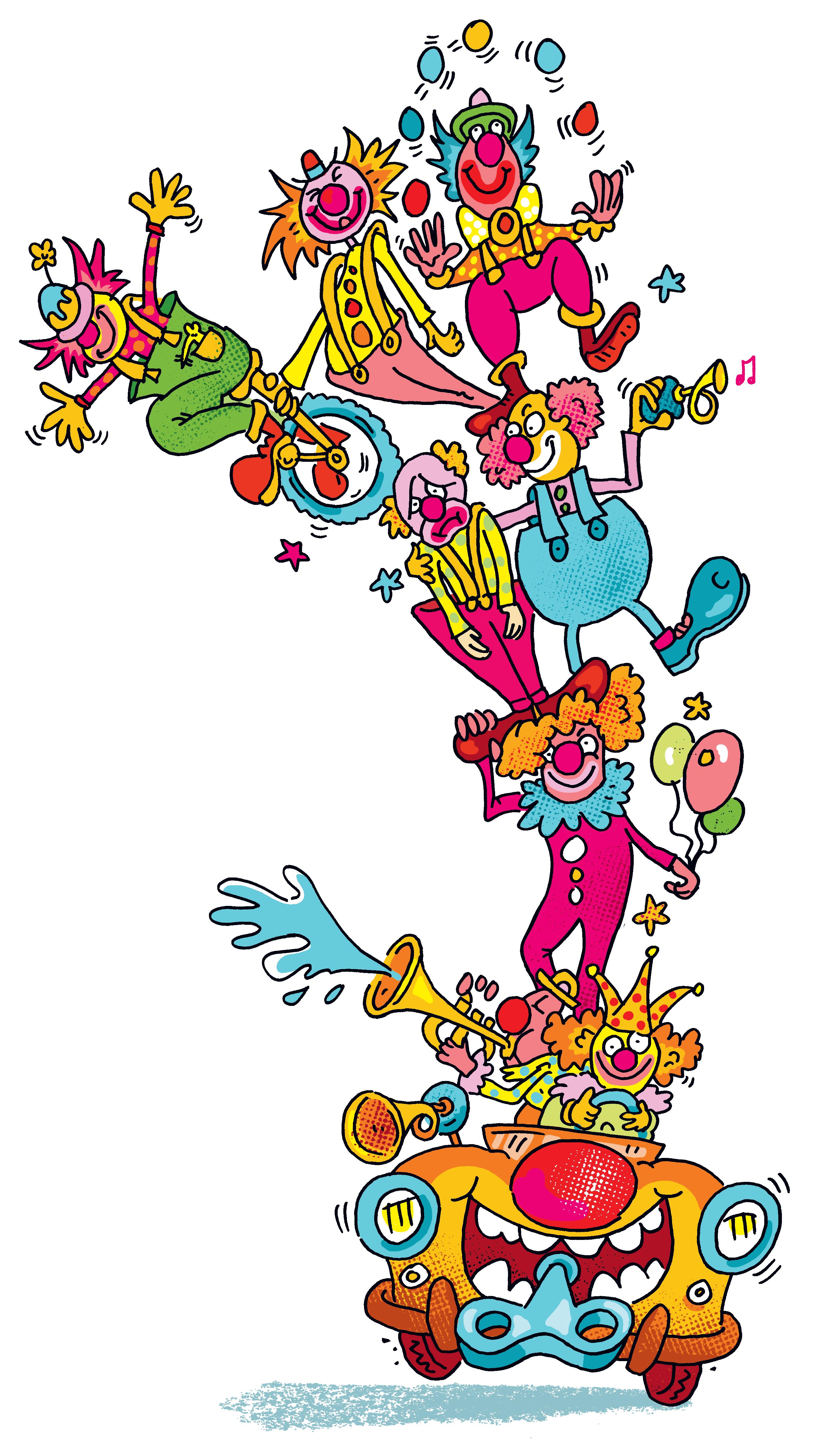

What did the egg say to the clown? You crack me up!

The largest recorded gathering of professional clowns took place in Bognor Regis, UK, in 1991. A grand total of 850 clowns gathered there for an annual convention, or meeting, of clowns.
Some people have a phobia, or fear, of clowns. It is called coulrophobia.
Specially designed clown cars can fit more than 20 clowns inside at the same time!
Clowns International, the world’s oldest society for clowns and clowning, was founded more than 75 years ago, in 1947.
The full name of Krusty the Clown in the animated TV comedy TheSimpsons is Herschel Shmoikel Pinchas Yerucham Krustofsky.
International Clown Week is celebrated each year between 1st and 7th August.
Clowns have a professional code called the Clown Commandments. These eight commandments, or rules, tell clowns how to act, dress and apply their clown make-up.
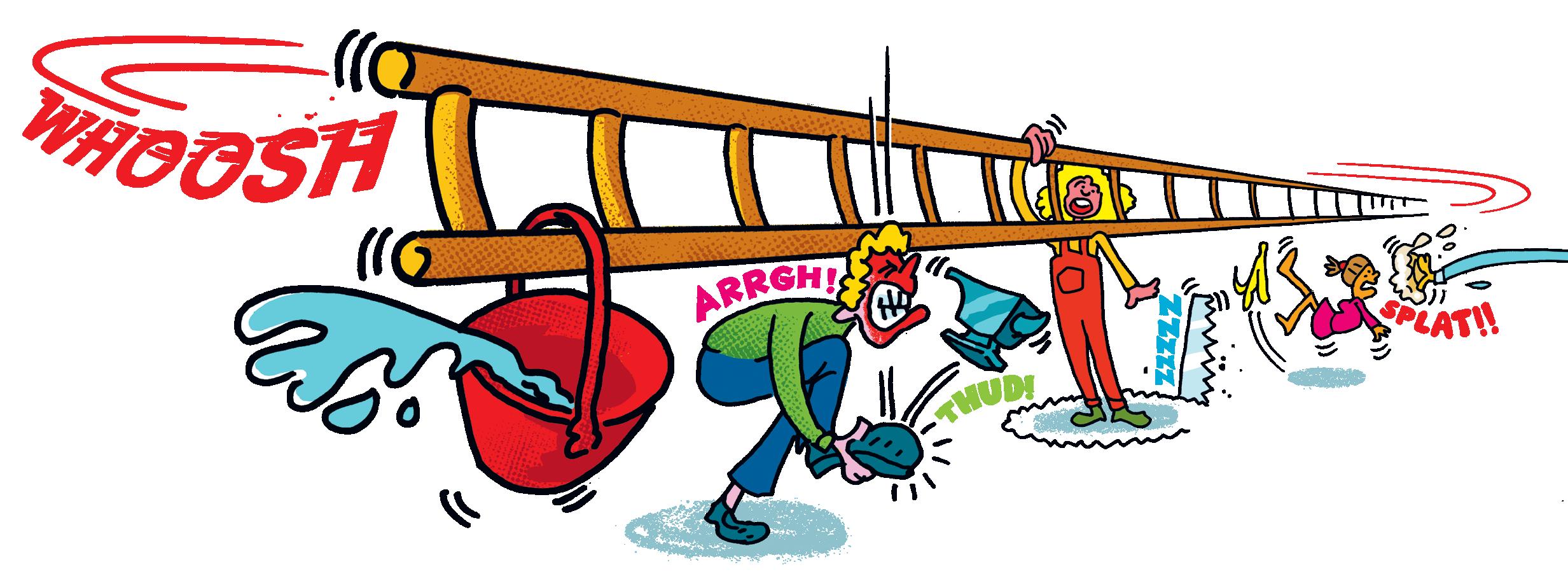
Find out how this popular type of physical comedy all began with a pair of actual wooden sticks.
Have you ever heard of the phrase ‘slapstick comedy’? Slapstick is a word used to describe a particular type of physical comedy in which funny accidents and other mishaps happen to people. Classic examples of slapstick comedy include someone accidentally slipping on a banana skin. Or someone (perhaps one of your grown-ups!) having a custard pie splatted in their face. Slapstick is often intended to look painful but any violence is actually made up for comic effect.
The origins of slapstick
A slapstick was originally a harmless paddle made from two pieces of wood which made a loud whacking sound when they were slapped together. In 16th-century Italian

theatre, the harlequin, who we met on the previous page, used it to loudly slap the bottoms of his comic victims!

Modern slapstick Slapstick comedy has been popular ever since. More recent examples of slapstick include Punch & Judy shows at the beach, the animated cat-and-mouse battles between Tom and Jerry, and the silent comedy TV series Man vs Bee and Mr Bean, both of which star actor Rowan Atkinson, who is a modern master of slapstick.
What is a bird’s favourite type of maths?
Owl-gebra!
Why did the dinosaur cross the road? Because the chicken hadn’t evolved yet!
What type of shoes do spies wear?
Sneakers!
What is a Viking’s favourite board game? Connect Thor!
What time do ducks wake up in the morning? At the quack of dawn!
How do you get straight As at school? Use a ruler!
What do you call an exploding monkey? A baboom!
What’s green and square? A banana in disguise!

Can you work out which games are played on the six boards shown on this page? Find out if you got them all on page 50.
Can you spot these 23 things hidden in the picture below? Plus, work out the two words the eight hidden

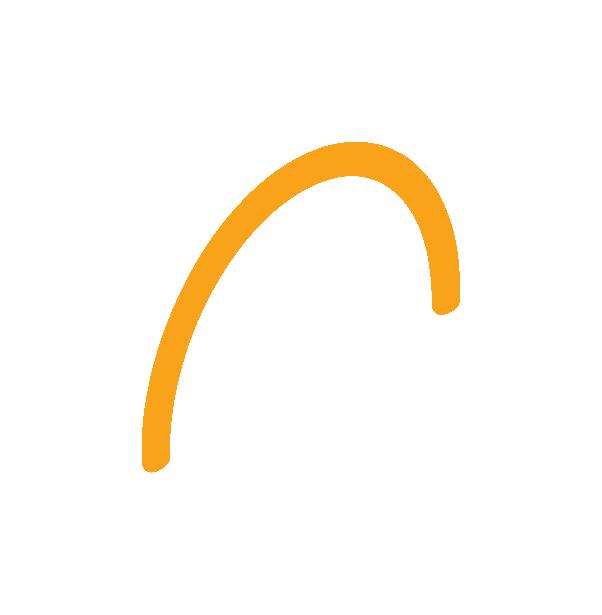





hidden letters spell. Clue: it’s a game played at school fairs. (You can find all the answers on page 50.)
Flutterthrough these fascinating facts about monarch butterflies
CANADA
ROCKY MOUNTAINS

MEXICO
USA
MONARCH MIGRATIONS
Breeding range
Summer
Spring
Winter
Summer migration
Spring migration
650 miles

Every autumn, monarch butterflies migrate thousands of miles from Canada to Mexico. The typical lifespan of a monarch is just two months. But those butterflies who are born before the journey south are able to live longer, for seven months. They spend the winter in Mexico and then lay eggs. The original butterflies that migrated die as they begin the journey back to
Canada. So it is the second, third or fourth generation of butterflies that eventually returns to Canada. How the new butterflies find their way, having never made the trip before, is a bit of a mystery. Scientists think that they are born with a knowledge of which direction to travel, and that they then use the position of the Sun in the sky to calculate their route.
Male monarchs have a small black spot on the hindwing, which females don’t.
Monarchs communicate by scent. Males attract females by releasing smells from their hindwings.
VEINS
Veins help butterfly wings keep their structure. They are filled mostly with air.
and their epic cross-countryadventures.

FOREWING
A monarch butterfly flaps its wings about 5 to 12 times per second. This is much slower than most butterflies, which are closer to 20 times per second.
LEGS
Butterflies have six legs, like all insects. But monarchs appear to have only four because their two front legs are tucked in close.
ANTENNAE
Monarch butterflies have light-sensitive antennae that help them to navigate using the position of the Sun.
Adult Eggs
Like all butterflies, monarchs go through a cycle of metamorphosis, growing from a caterpillar (larva), forming a chrysalis and transforming into an adult butterfly. After hatching from an egg, the caterpillar’s job is to eat. As they eat and grow, monarch caterpillars can increase their weight about 2,700 times!
A monarch caterpillar undergoes metamorphosis, changing from a chrysalis into an adult butterfly, in about 8 to 15 days.
Chrysalis
Larva

Female monarchs have thicker wing veins and tend to be darker in colour.

Antennae
Eyes
Proboscis
Palpi
These ridges are covered with furlike scaly sensors that monarchs use to help them smell.
Most of the solar system is empty space. But as well as the Sun, planets, dwarf planets and moons, you can find asteroids and comets. They are made from dust and rock left over from the formation of the solar system.



Asteroids
Asteroids are rocky objects that aren’t big enough to form a planet.
Meteoroids
Meteoroids are small pieces of rock or metal less than 1 metre across.

Meteors
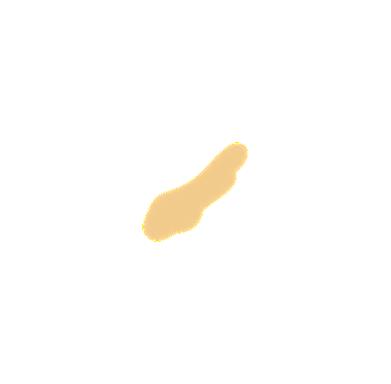


Often called ‘shooting stars’, meteors are meteoroids that burn up as they enter Earth’s atmosphere, giving off a streak of light.
Comets are born in two outer regions of the solar system, the Kuiper Belt, a vast icy region beyond the orbit of Neptune, and the Oort Cloud, an even more distant region far beyond dwarf planet Pluto. Sometimes comets pass close to the Sun. When this happens, some of their solid ice turns to gas, producing the comet’s spectacular tail.
Meteorites
Meteorites are parts of meteors that don’t vaporise as they enter Earth’s atmosphere and land on the surface of the planet intact.


Comets
Distance from Earth



Great September Comet 1882


Ikeya-Seki 1965

Halley’s Comet 240 BCE



Comets are clusters of rock, dust and ice orbiting the Sun. There could be as many as a trillion comets in the outer reaches of the solar system.
Vredefort Crater 300 km


McNaught 2006

Hale-Bopp 1995

Most asteroids that hit Earth’s atmosphere burn up before they reach Earth’s surface. However, once every few million years, an asteroid that is large enough to cause significant damage collides with Earth — and leaves behind a giant crater. The faster the asteroid is travelling, the bigger the crater it can make. These are five of the biggest known asteroid impacts on Earth.
The asteroid that probably caused the extinction of the dinosaurs 66 million years ago is estimated to have been 14 kilometres wide and travelling about 150 times faster than a jet aeroplane when it struck Earth.
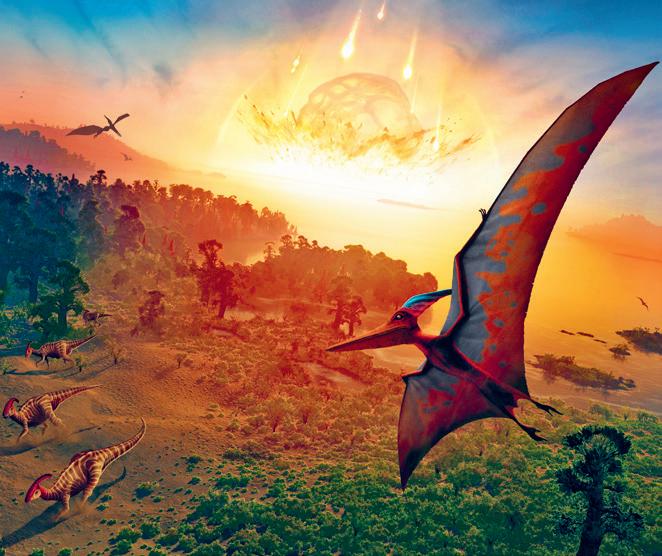
Chicxulub
SCALE
The diameter of each comet is relative to its dimensions in real life. The length of the tail is measured by how many degrees across the night sky it appeared to stretch (each degree is equivalent to about two full Moons in a row). The colour of the comet indicates how bright it looked from Earth (lighter colour = brighter comet). The year is the year the comet was first recorded.
TheSun’sbrightnessis-27
Planets found outside our own solar system are called exoplanets.
The first exoplanets were discovered in 1992. Since then, astronomers have found more than 5,000 of them, with the number of discoveries doubling roughly every two years.
Exoplanets vary in size. Some are smaller than Earth. Others are several times larger than Jupiter.
This infographic shows every exoplanet that we have discovered so far.
Proxima Centauri b
The closest exoplanet to Earth, it orbits the star Proxima Centauri.
GJ 1214 b
This exoplanet may have no land whatsoever, as its entire surface could be covered by a single hot, watery ocean.
13x
HD 189733 b
Scientists think that it could rain glass on this exoplanet!
PSR B1620-26 b
This exoplanet is thought to be 13 billion years old, which is nearly three times older than Earth.
our solar system)
HD 100546 b
The largest known exoplanet. It is more than six times bigger than Jupiter.
HAT-P-7 b
Scientists think it could rain rubies and sapphires on this exoplanet.
TrES-2 b
This exoplanet is blacker than a lump of coal. Sometimes called the Dark Planet, it reflects less than 1 per cent of the light that hits it.
109x Earth’s radius Don’tforget about me! Earth Jupiter Sun SCALE (the largest planet in

Stumped? Don’t worry, you can find the answers to all the puzzles on page 50.
Can you spot the 20 funny-sounding words hidden in our jumbo word search puzzle? Good luck!
D F U D N Y K N C I E
K B S A G O I D G O R S O H B J B I Y Z
E G E J C P L B F O X Z L A C O L D H B
R B C A E P E H B D Z J V G N L H Q W T
F J X J L L P M C L V P O O M P H S N X
U D G E O R Z Y E E E Q R O N O Z S H A
F P G P L A U O A S N E S Q H E A M T K
F D P D L B S K O O Z D A G N Y V R G T
L B J C Y W B V L B S C R B M R K L O O
E S N T G X Q I E W M X S L S N U O T Z
L O V C A S W Z W G G A R C Q Y T A O Z A O N Z G B X P E F H B B N B L S F O K
B I B B L E W B J L X S J C E Y Z J Y P
The six-sided
on the left can be
up to form a cube. Only two
the cubes next to it can be made by it.
are they?
BAMBOOZLE
BIBBLE
FLAPDOODLE
GADZOOKS
HOBNOB
KERFUFFLE
KOOKY
LOLLYGAG
MOOCH
OOMPH
PIFFLE
QUIBBLE
SCHNOZZLE
THINGAMAJIG
TOOTLE VAMOOSE
Can you spot all 2O differences between these two science lab illustrations?
Use the word wheel to help find the answers to the five clues below. All the answers contain the middle letter, and each letter can only be used once.
Clue: a strip of hair left to grow on an adult’s upper lip (9 letters).
Answer:
Clue: what you wear to a fancy dress party (7 letters).
Answer:
Clue: a space object made of rock and ice that usually has a tail (5 letters).
Answer:
Clue: an exclamation people use when in pain (4 letters).
Answer:
Clue: a repeated sound that has been reflected back to the listener (4 letters).
Answer:
Can you find your way through our maze of square rooms?
Enter through the door marked with the red arrow, then try to find your way to the exit by going through the correct sequence of open doors. Good luck!

Fill in the missing numbers so that every row and column includes the numbers 1, 2, 3 and 4. Use the inequality signs as clues and make sure numbers always obey the inequality sign between them. This means that the arrows between the numbers always point towards the smaller number.
Here is an example:
In the three squares shown above, the number A must be less than 3 and greater than the missing number B. We know all the numbers must be between 1 and 4 , so therefore A must be 2 and B must be 1.
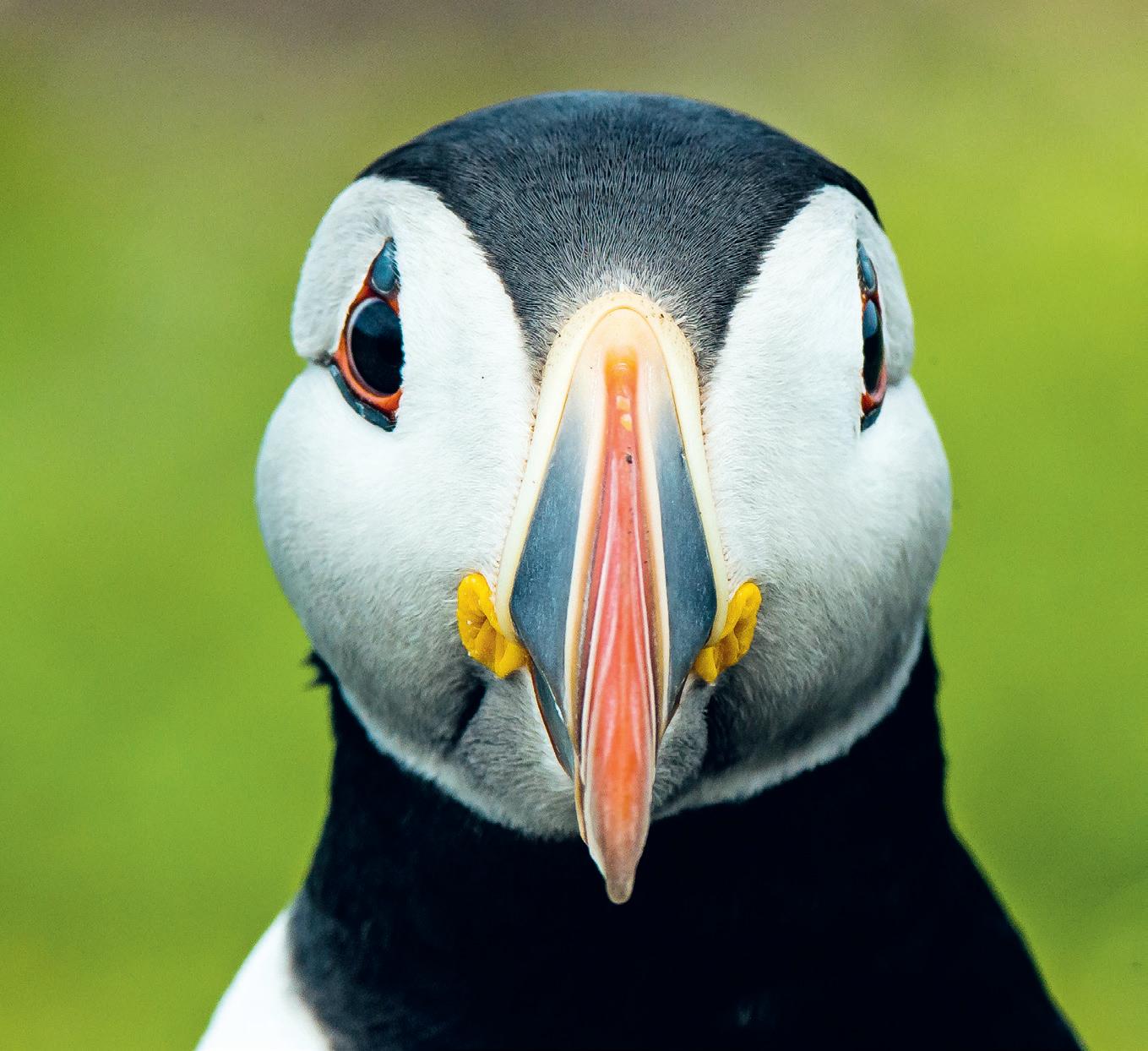


Can you work out what you are looking at in each of these seven photos?


Draw a line to connect each pair of planets. You can’t use diagonal lines and the lines can’t cross or touch each other. You must fill the whole grid with lines but only one line is allowed in each square.
In the triangles below, the numbers inside the squares are the sum of the two numbers in the connected circles. For example:

Can you work out which number should appear in each of the circles? All the numbers in the circles are between 1 and 10 and a number can only be used once in each triangle.
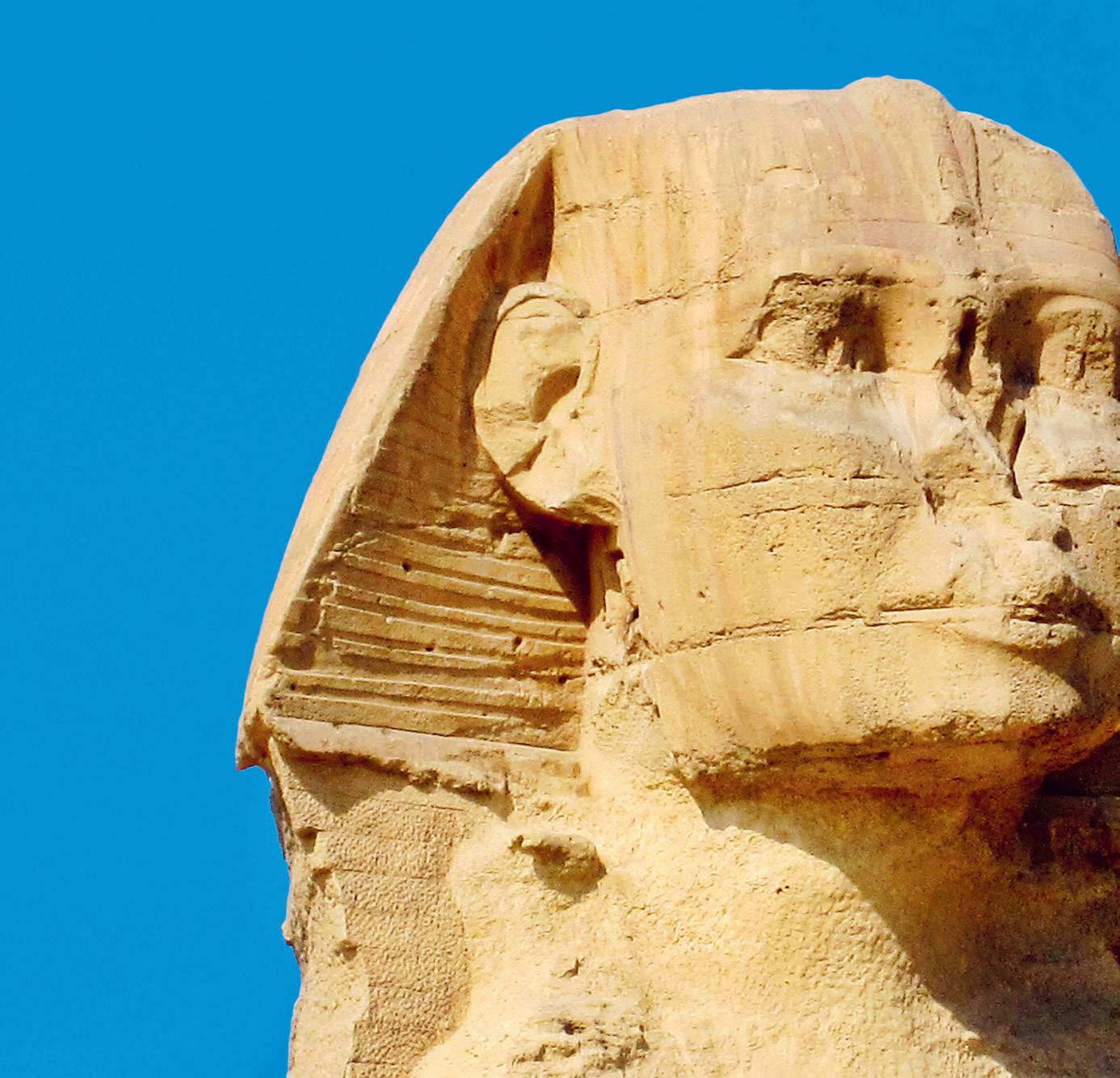
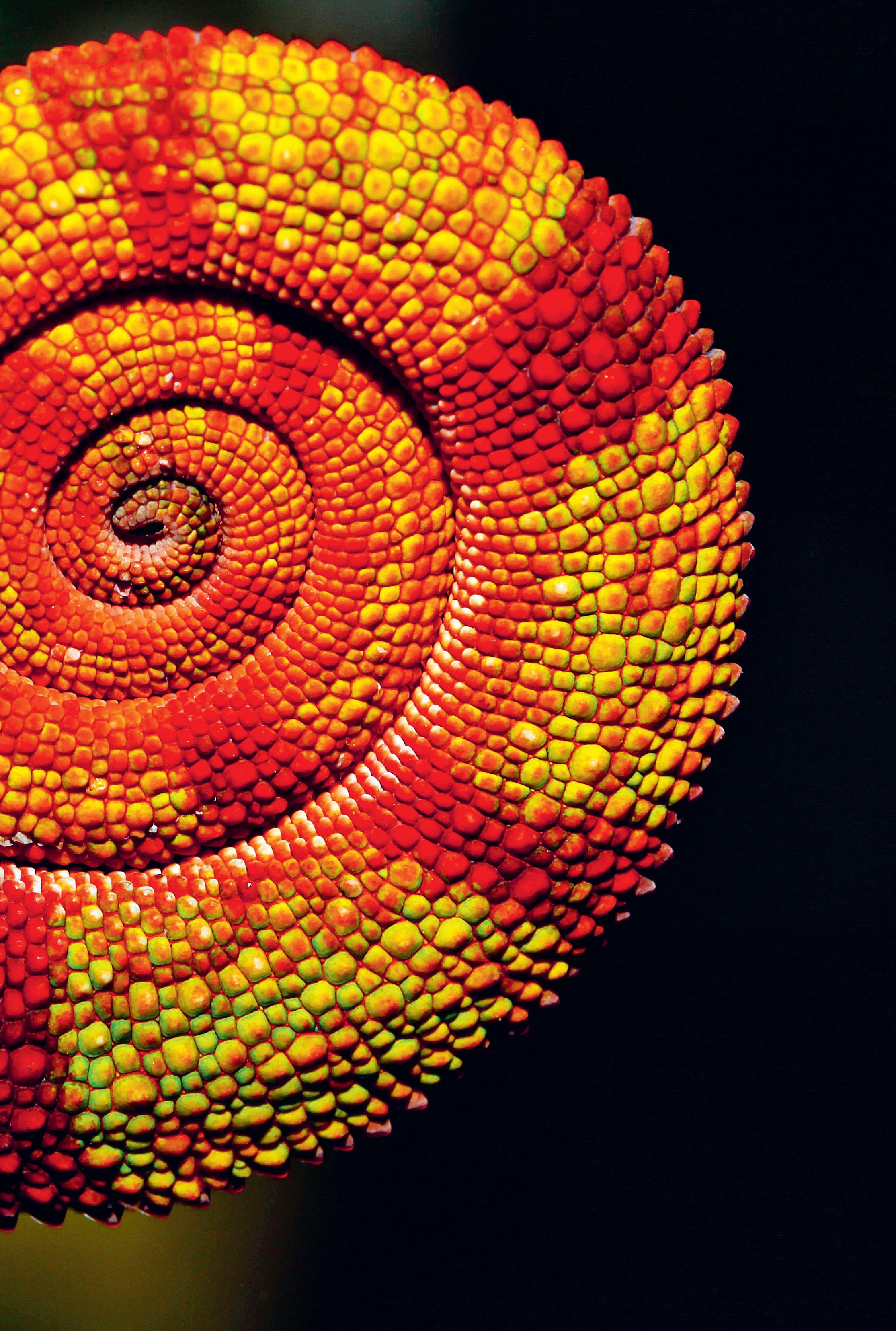
Fill all the empty squares so that every row, column and 3x2 box contains each of the numbers 1 to 6.


In a fascinating extract from a brilliant new book by scientists Sarah Darwin and Eva-Maria Sadowski, we explore the story of evolution and how it has shaped the natural world – including you!
All species of living things interact with other species out in the wild. This can cause them to evolve in a way that affects one another. When species evolve together it is called coevolution. Flowers and their pollinators offer some great examples of coevolution. Flowers often depend on insects and other animals to help them spread their pollen and seeds. Sometimes these plants and animals become completely dependent on one another. These species are then linked together in the never-ending dance of evolution
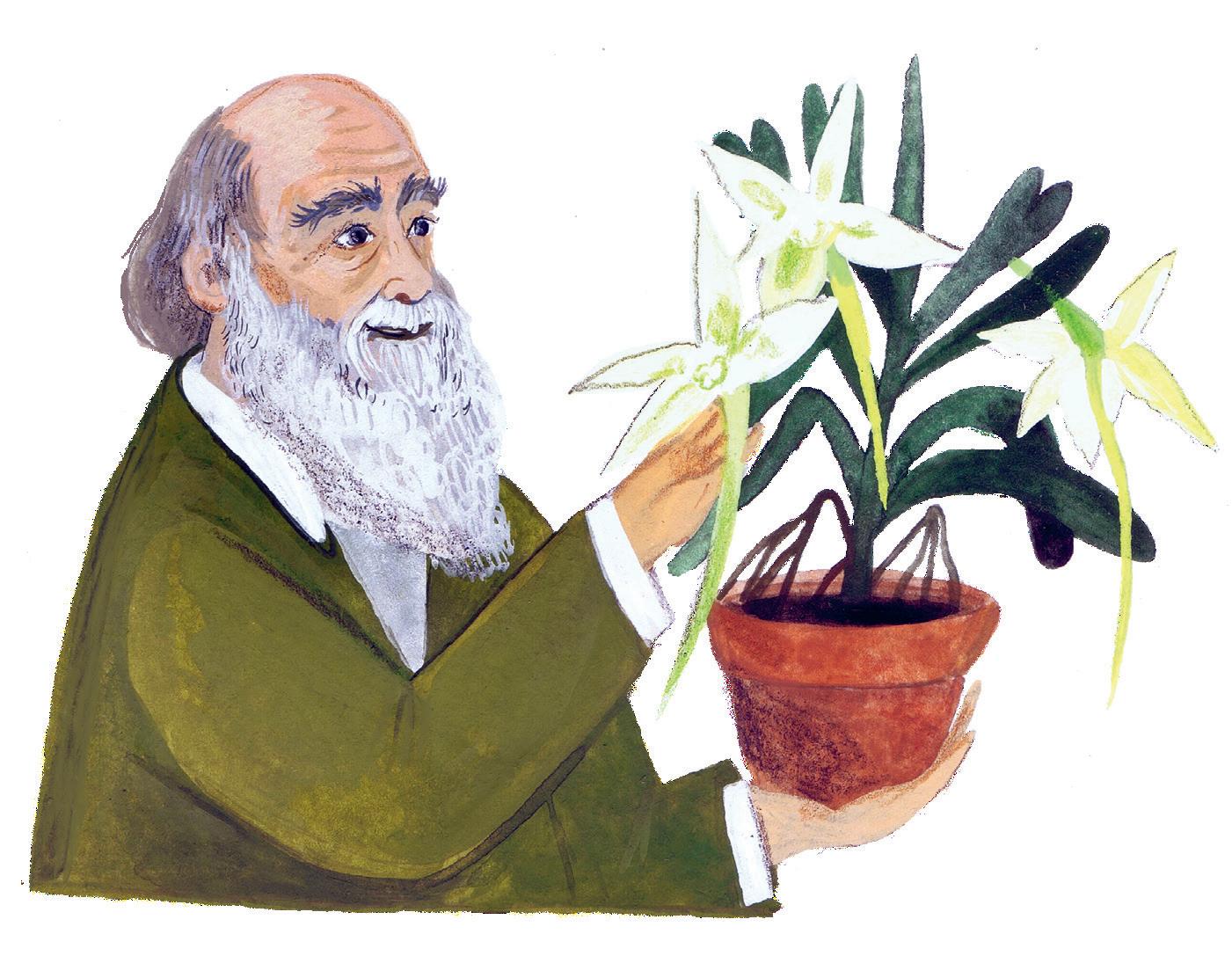

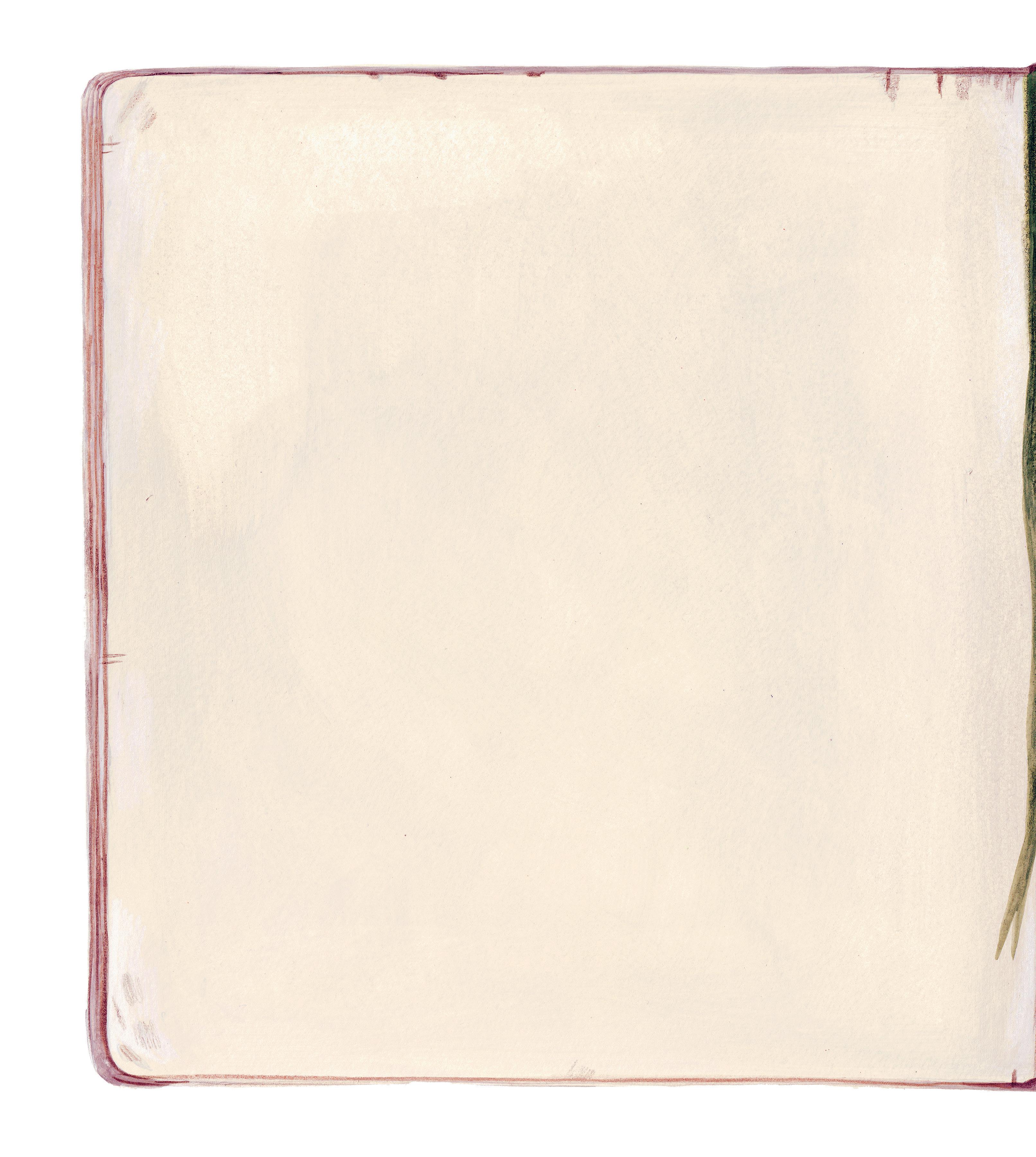 Madagascan star orchid
Charles Darwin
Madagascan star orchid
Charles Darwin
In 1862, Charles Darwin was sent an interesting flower to study – an orchid from Madagascar Darwin looked at the flower and noticed that it kept its nectar at the bottom of a 30-centimetre-long tube. He predicted that its pollinator must have an equally long tongue to
reach the nectar . A few years later, evolution scientist Alfred Russel Wallace predicted this orchid’s pollinator would be a type of hawk moth. Eventually , Darwin and Wallace were both proved right, and we now know that this orchid and moth must have coevolved over time.

Coevolution takes place gradually by natural selection. In the case of this orchid and moth, they both probably had ancestors with slight variations, such as tubes and tongues of different lengths. Over time, the flowers with the long tubes and the moths with the long tongues became most successful. The moth had

When the hawk moth isn’t slurping up nectar, it keeps its 30-centimetre tongue rolled up out of the way.



to compete with other species for the orchid’s nectar, but its long tongue meant that it was better suited to the long-tubed flower Perhaps the other competitors died out or found other food sources. It is helpful for the moth to have its own source of nectar and for the orchid to have a reliable pollinator . It’s a win-win situation!



Pollinators are animals, such as some insects, birds, bats or other small mammals, that carry pollen between flowers. These animals feed on the flower’s sweet nectar or pollen. When a pollinator visits a flower , some pollen grains can get stuck to its body . As the animal travels between flowers, the pollen can brush off on the next flower . The pollen fertilises the plant, allowing it to make seeds. Some pollinators are attracted to flowers because of their colour or scent, or even because they look like a potential mate!
At the same time, pollen from the flower’s stamen is rubbed on the honeybee’s body and sticks to ‘baskets’ on the honeybee’s legs.
The honeybee lands on the next flower to drink nectar, rubbing pollen from the first flower off against the stigma.
Stigma
Petal
Pollen grains land on another flower’s stigma.
Stamen
Receptacle
The honeybee visits flowers to collect sugary nectar. (Honeybees turn nectar into honey.)
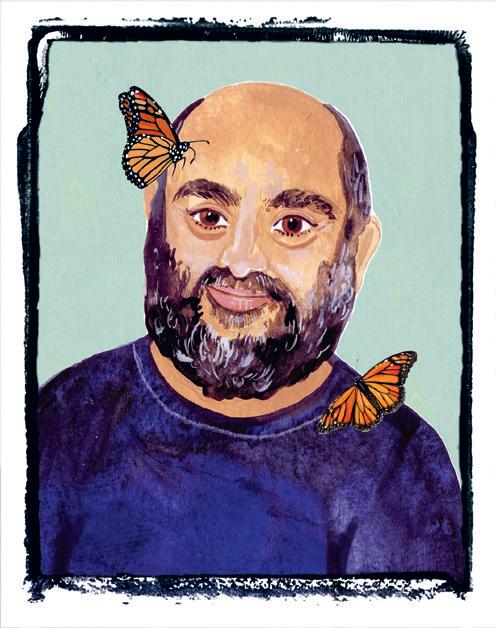
Pioneering people
Anurag Agrawal (1972–present) is an expert in coevolution in milkweed plants and monarch butterflies. He recently found out that monarch caterpillars are able to convert the milkweed’s poison into less harmful substances.
Milkweed

Monarch butterfly. To find out more about monarch butterflies, turn to page 28.
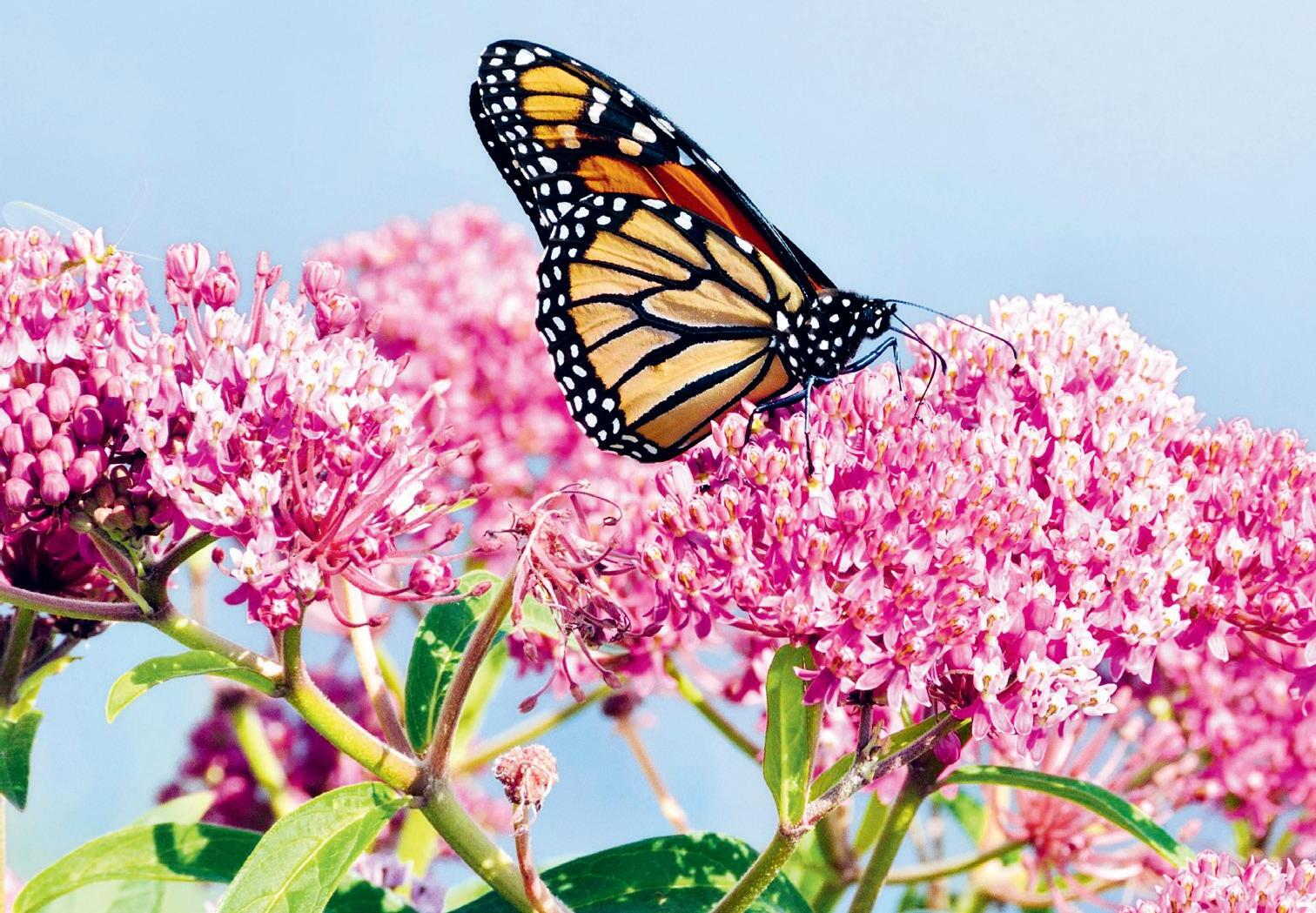



The honeybee continues to transport pollen from flower to flower.


Sometimes coevolution benefits both species, but other times two (or more) species are working against one another . Take the milkweed plant and the caterpillar of the monarch butterfly, for example. The caterpillar likes to munch on the milkweed’s leaves, so the plant evolved dense hairs to protect itself. But the caterpillar then evolved to nibble the hair off before eating the leaf! So the milkweed evolved a way to make
a poisonous liquid. But the caterpillar evolved so that it could tolerate the poison. Each time the plant finds a new way to protect itself, the caterpillar finds a way around the obstacle. Both species coevolve: one to protect itself and the other to feed itself safely
Evolution, written by Sarah Darwin and Eva-Maria Sadowski and illustrated by Olga Baumert, is out now.


 Monarch butterfly caterpillar
Monarch butterfly caterpillar
Your guide to the wonderful world of linguistics and languages. This month: tongue-twisters!
Have you ever found something so difficult to say that it felt like your tongue got tied up in knots?
Tongue-twisters are a fun way to practise pronunciation. They usually involve a lot of similar sounds, which can get your brain – and your tongue! – all twisted up and in a muddle. Actors sometimes recite tongue-twisters before they perform in order to get the muscles in their mouths, throats and tongues feeling warmed up and flexible.
See how you get on with these tricky tongue-twisters. Try saying each one five times as fast as you can!
A noisy noise annoys an oyster.
The sixth sick sheikh’s sixth sheep’s sick.
I saw a kitten eating chicken in the kitchen.
Askunksatonastumpandthunkthestumpstunk, but the stump thunk the skunk stunk!
Twisters in Translation
For a bonus challenge, here are three tricky tongue-twisters that aren’t in English!
GERMAN
'Fischers Fritze fischt frische Fische; Frische Fische fischt Fischers Fritze.'
(Translation: Fritz, the fisherman’s son, fishes for fresh fish; For fresh fish fishes Fritz, the fisherman’s son.)

so Betty bought better butter but the butter was bitter,
Betty bought butter, to make the bitter butter better!
ARABIC
'Al mishmish dah mish min mishmishkum wa kaman al mishmish dah mish min mishmishnah.'
(Translation: The apricot is not your apricot and the apricot is also not our apricot.)
JAPANESE
'Uraniwa ni wa niwa, niwa ni wa niwa niwatori ga iru.'
(Translation: There are two chickens in the back garden, and two in the front garden.)



30
The length of a blue whale in metres, which is about as long as a Boeing 737 aeroplane.

160,000
The blue whale’s total weight in kilograms, which is roughly the same as 20 full-grown African elephants.
80-90
The lifespan of a blue whale in years.
5,000
The amount of air in litres that blue whales can breathe into their lungs. An adult human’s lungs can hold 6 litres.
25,000
The approximate number of blue whales living in the wild.
90
The weight in kilograms that a baby blue whale gains each day as it grows, which is more than the weight of some adult humans.
40 million
The number of shrimp-like krill a blue whale can eat in a day.
180
The weight of a blue whale’s heart in kilograms.*
*A blue whale’s blood vessels are so wide you could swim through them!

Help What on Earth! Magazine celebrate our second birthday with the unusual facts about birthday fun crammed into these irresistible lists.
Ten unique ways birthdays are celebrated around the world
1 Canadians grab the person who is celebrating their birthday and coat their nose in butter in order to ward off bad luck.
2 At birthday parties, Mexicans hit a papiermâché piñata (which is pictured on the right) with a stick while wearing a blindfold. After repeated hits, the piñata breaks open and the sweets and toys stashed inside fall to the ground.
3 Jamaicans throw flour all over the person celebrating their birthday in a tradition called ‘antiquing’.*
4 Argentinians pull the ears of the person celebrating their birthday: one tug for each year of their life.
5 In Ireland, children celebrating their birthdays are sometimes held by their legs upside down by family and friends and then gently

‘bumped’ on the floor once, for every year of their life – with an extra bump at the end for good luck.
6 In the Netherlands, people celebrate particular birthdays more than others. These special years are called Crown Years and happen when you’re aged five, ten, fifteen, twenty and twenty-one.


7 In Ghana, instead of celebrating birthdays with a cake, children are given a special breakfast treat called oto, which is made from fried yams, a type of root vegetable.
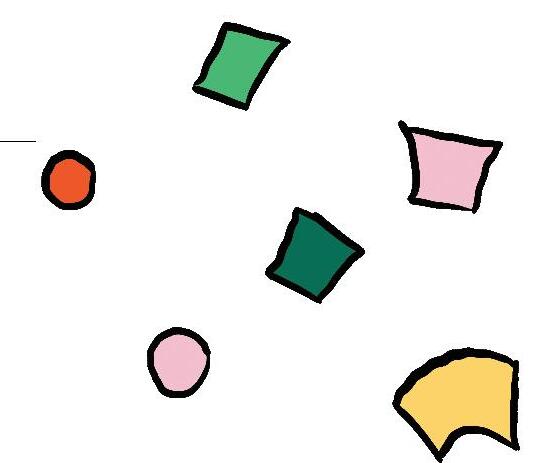
8 In Russia, instead of a birthday cake, the person celebrating a birthday receives a homemade pie which has a personal message carved into the dough on the top.
9 In China, people eat a bowl of long noodles on their birthdays. The noodles, which you can see a girl eating in the photo on the left, represent long life, and the aim is to slurp the noodles into your mouth as far as possible before taking a bite. The longer the noodles you manage to suck up into your mouth, the longer you will supposedly live!**
10 Australians prepare a special treat called fairy bread on birthdays, which is buttered bread covered in coloured sugary sprinkles. It sounds delicious!

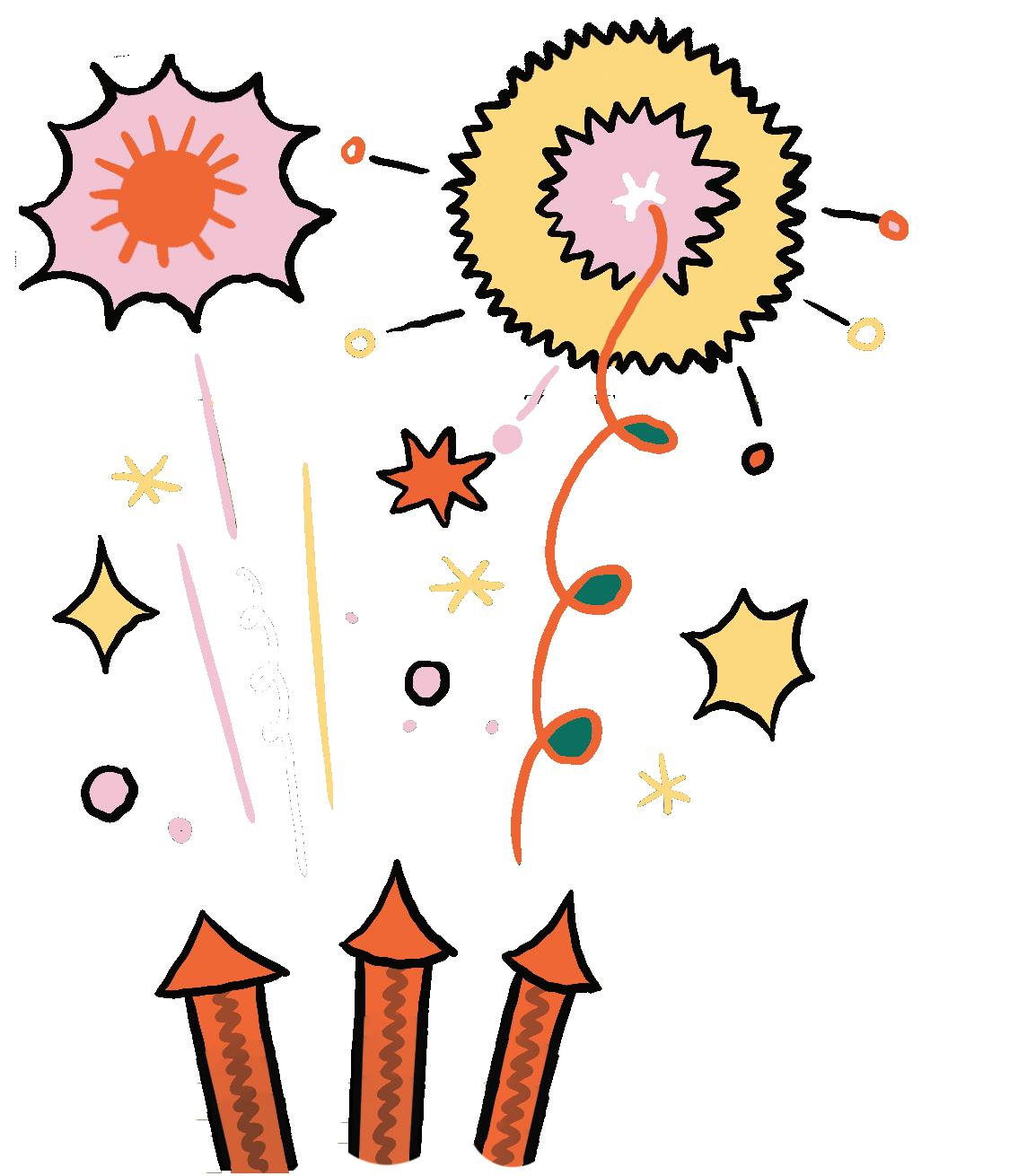
*In the nearby South American country of Brazil, antiquing gets even messier because it also includes eggs!

**In China, people sometimes also ‘skip’ certain birthdays because these years are considered bad luck. For example, some Chinese
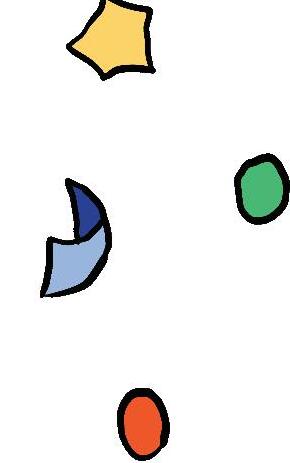
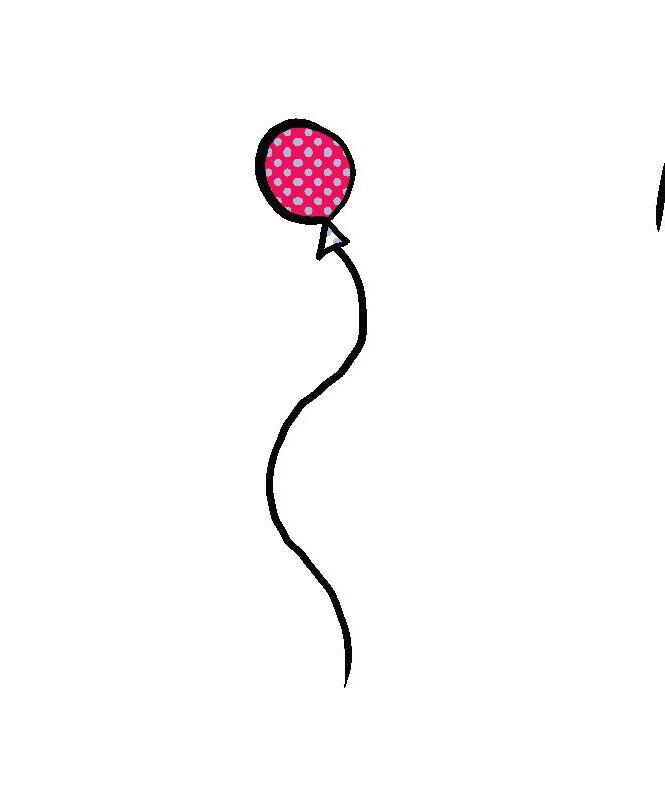
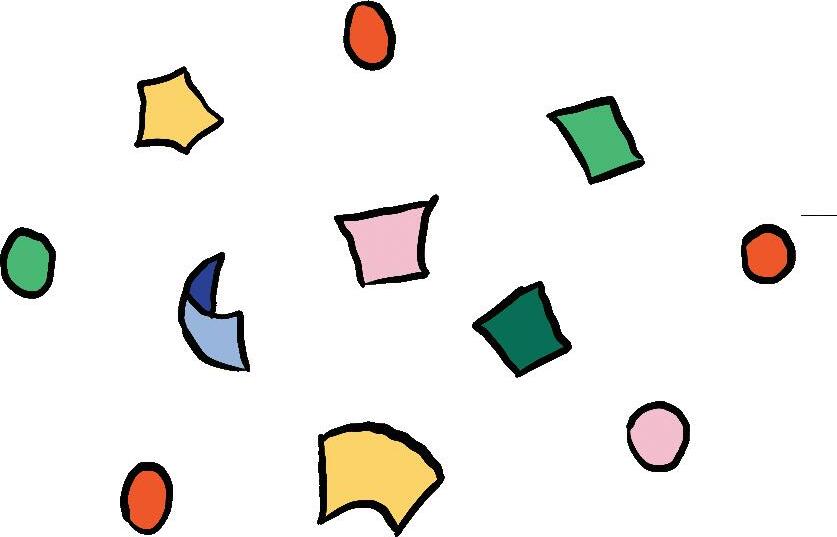


Eaten on their own, the seeds of the cacao tree –shown in the illustration on the right – have a strong, bitter taste. But once the seeds, which are also called cocoa beans, have been correctly prepared, their insides can be ground into cocoa, which is the key ingredient of chocolate.
4.4 million
The approximate weight in tonnes of all the cocoa produced each year.
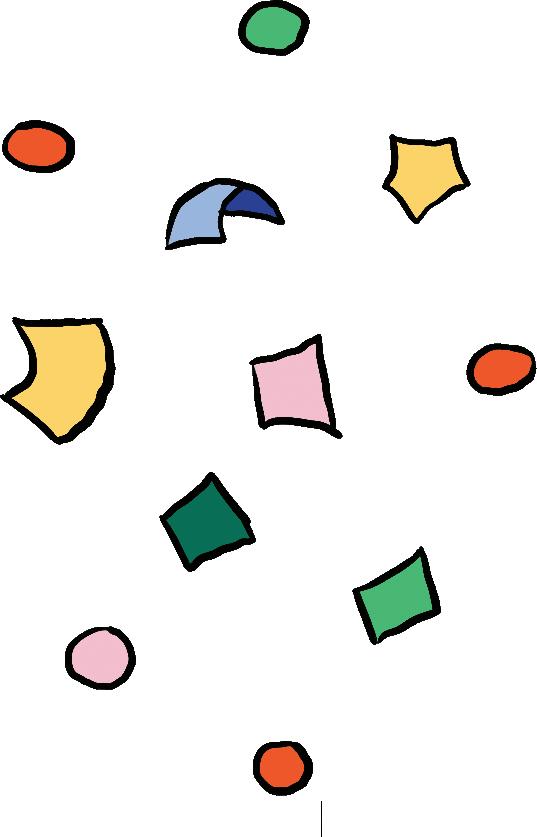
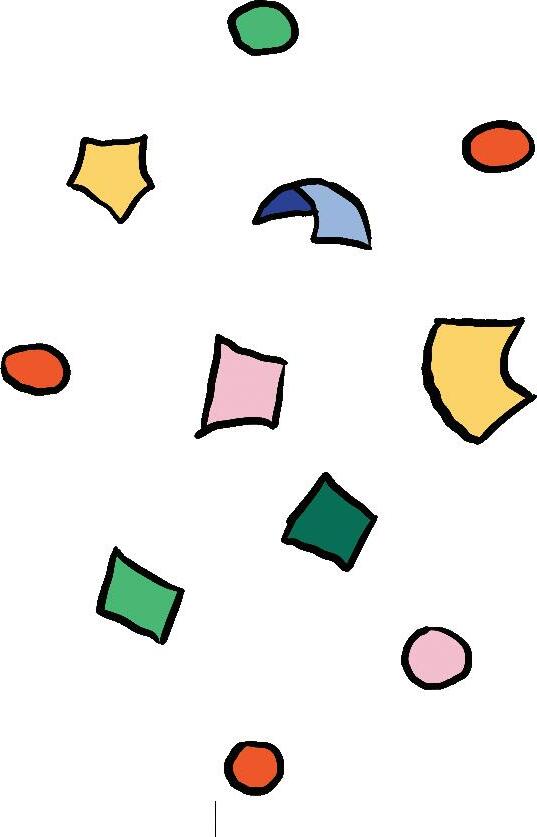
women avoid celebrating their 30th, 33rd and 66th birthdays, while some Chinese men don’t celebrate their 40th birthday. Instead, they simply stay 29, 32, 65 or 39 for two years in a row!

Above: in Mexico, people celebrate birthdays by hitting a piñata to release the sweets and toys inside.

5,792.5
The weight in kilograms of the world’s heaviest chocolate bar, which is the same as three pickup trucks. The gigantic chocolate bar was approximately 4 metres long, 4 metres wide and 35 centimetres thick.
1,200
The average number of cocoa beans produced by one cacao tree in a year.

1847


by Forrest Mars Sr. He had the clever idea during the Spanish Civil War, after noticing soldiers eating small chocolates with sugary shells. As well as being sweet and tasty, the sugary coating stopped the chocolate from melting in their hands.
50
The number of cups of hot chocolate the great Aztec emperor Montezuma II drank each day from a golden cup.
45
The number of cacao beans it takes to make a typical 50-gram bar of chocolate that you might buy in a shop.
30
The year the world’s first chocolate bar was made. It was produced by the English company Fry’s, which later became part of the chocolate and sweets company Cadbury.
1941
The year sugar-coated M&M’s were first produced
The percentage of the world’s cocoa beans that come from the Ivory Coast in West Africa.

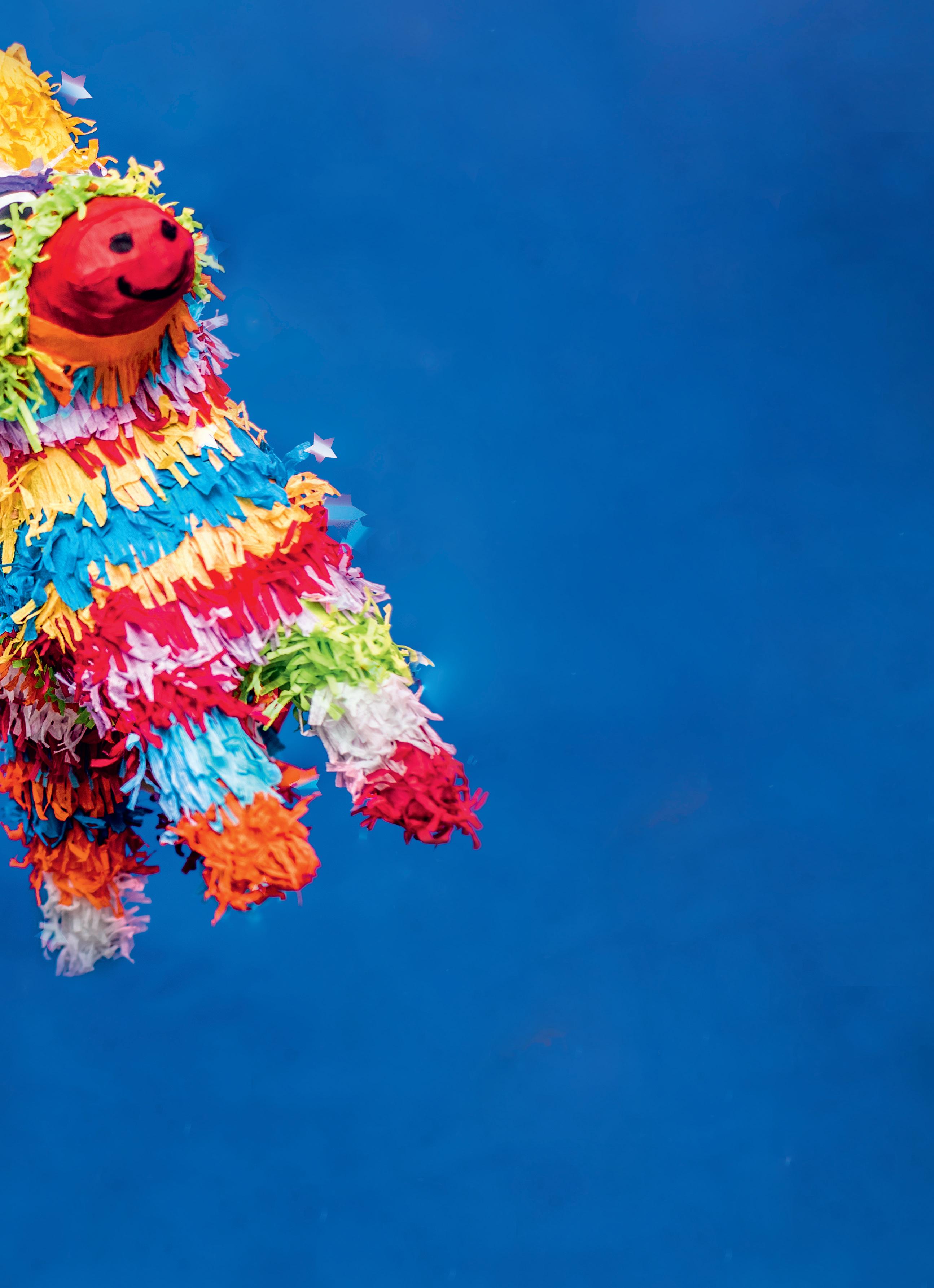
Test your family’s brainpower by playing the What on Earth! Quiz together. Regular readers may have an advantage because some of the facts appeared in previous issues of the magazine. Don’t worry if you don’t know them all, though – the answers are at the end of the quiz!
1 Which of the following animals could you never encounter on an expedition to the North Pole?
a. Walrus
b. Penguin
c. Polar bear
d. Arctic fox
2 Which of the following words is a collective name for a group of cheetahs?
a. A pride
b. A sprint
c. A coalition
d. A claw
3 Which animal can jump the furthest distance relative to the size of its body?
a. Grasshopper
b. Kangaroo
c. Snow leopard
d. Flea

14

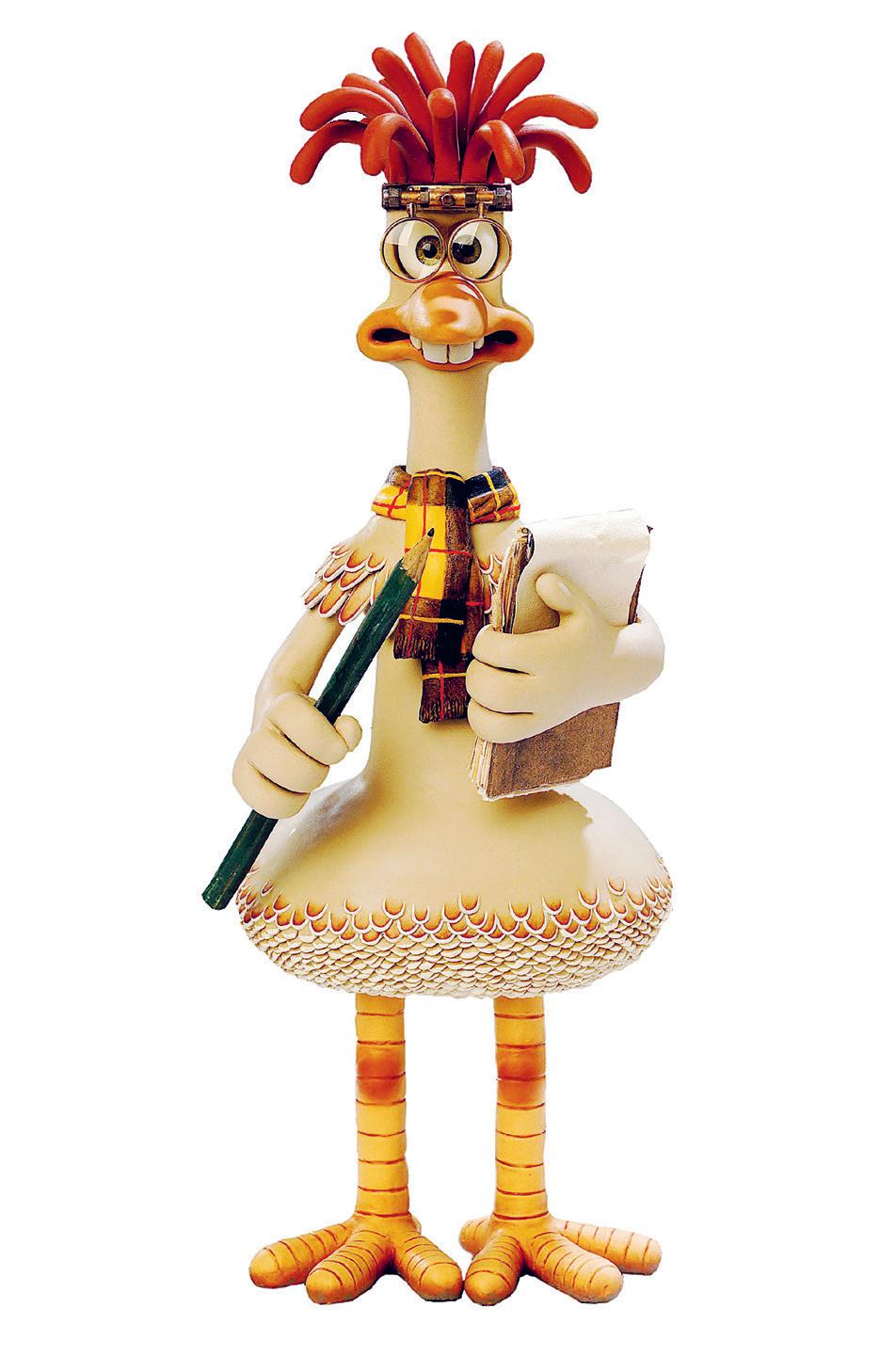
15
4 In what year is it estimated that Jonathan the tortoise, the world’s oldest living land animal, was born?
a. 1632
b. 1732
c. 1832
d. 1932
5 Which is the only planet in the solar system that would float in a bath (if you could find one big enough!)?
a. Saturn
b. Mercury
c. Uranus
d. Neptune
6 In total, how many astronauts have walked on the Moon?
a. 6
b. 12
c. 18
d. 24
7 What natural phenomenon is called a tsunami?
a. A giant tree
b. A giant fish
c. A giant wave
d. A giant flower
8 Which scientist proposed the theory of gravity?
a. Charles Darwin
b. Marie Curie
c. Albert Einstein
d. Isaac Newton
9 Which is the hottest of these four things?
a. A bolt of lightning
b. The surface of the Sun
c. Earth’s core
d. Inside a volcano
HUMAN WORLD

9

a. Swallowing
b. Smiling
c. Taking a step
d. Blinking
11 Louis XIX of France, who was born in 1775, is thought to be the shortest-reigning monarch in history. How long did King Louis XIX’s reign supposedly last?
a. 20 minutes
b. 20 hours
c. 20 days
d. 20 weeks
12 Approximately how many bacteria are living inside your mouth? (Don’t worry, many of them are helpful!)
a. 6 million
b. 60 million
c. 600 million
d. 6 billion
Each of these emoji sequences represents the title of a popular children’s book. Can you work out the name of each book?
c. Early Man
d. Flushed Away
GEOGRAPHY
16 The oldest continuously used national flag is thought to be more than 800 years old. Which country’s flag is it?
in Transylvania, a real region of Eastern Europe. In which country is Transylvania located?
a. Romania
b. Hungary
c. Croatia
d. Bulgaria
19 Which is both the largest and deepest of the world’s oceans?
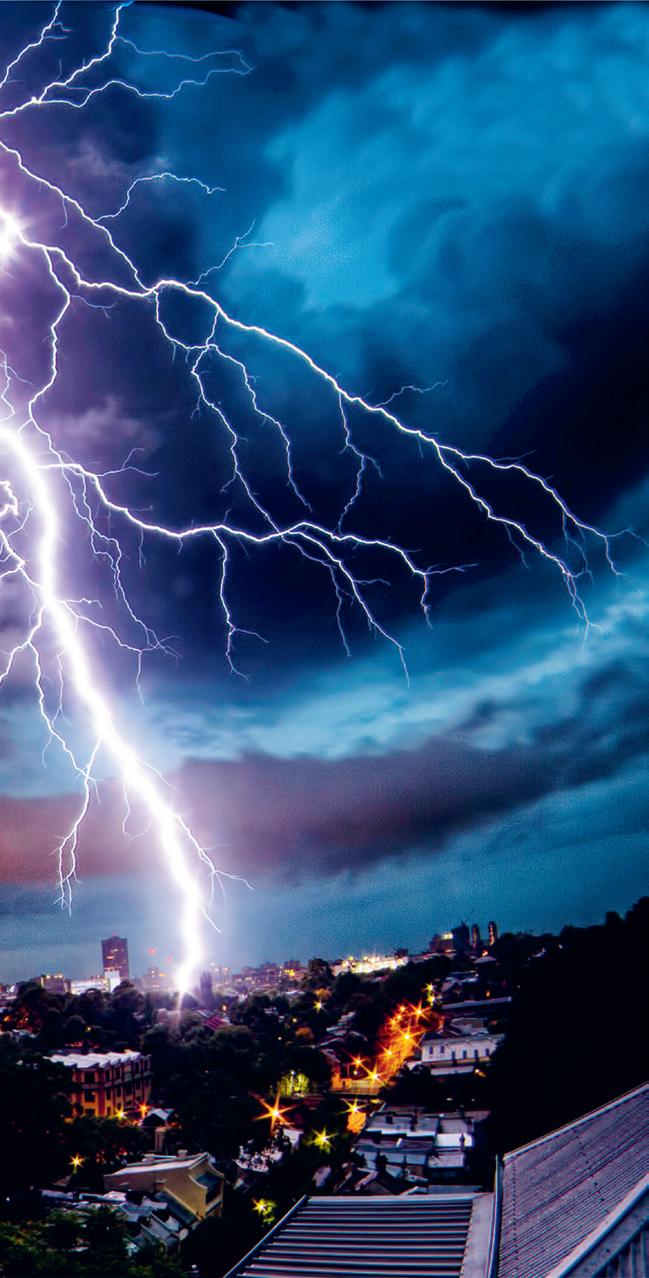
13 How old was Jordan Romero when he became the youngest person to climb to the summit of Mount Everest?
a. 15
b. 16
c. 17
d. 18
14 What is the most visited building or monument in the world, attracting more than 15 million people each year?
a. Eiffel Tower, France
b. Statue of Liberty, USA
c. The Forbidden City, China
d. Great Pyramid of Giza, Egypt
15 Which of the following movies was not created by the stop-motion animation studio Aardman?
a. Chicken Run
b. The Secret Life of Pets
a. England
b. Japan
c. Norway
d. Denmark
16
17 The Danube flows through more countries than any other river in Europe. How many countries does it flow through?
a. 4
b. 6
c. 8
d. 10
18 Dracula, the fictional vampire created by the 19th-century writer Bram Stoker, is supposed to live
a. Atlantic Ocean
b. Arctic Ocean
c. Pacific Ocean
d. Indian Ocean
20 Which of the following four countries is not part of the continent of Asia?
a. Thailand
b. Egypt
c. Malaysia
d. India
E: The Tiger Who Came to Tea.
C: Charlie and the Chocolate Factory; D: The Lion, the Witch and the Wardrobe;
– A: Goldilocks and the Three Bears; B: The Cat in the Hat;
Each month we feature an amazing story from world history taken from the bestselling book by Christopher Lloyd, with illustrations by Andy Forshaw. This month: Genghis Khan and the Mongol Empire!
In the early 13th century, changes were afoot all over the world, but especially in Asia. We know about year-byyear climate changes on the grasslands of Mongolia, north and west of China, because in 2014 scientists Neil Pederson and Amy Hessl worked out something quite amazing. If you’ve ever looked at the end of a log, you know you can see rings there. Each of those rings is the new growth of a particular year, so you can count the rings to learn how old a tree is. And you can see by the width of the rings how warm and wet (or cold and dry) each year was.
Pederson and Hessl looked at very old trees in Mongolia and found that there was an intense drought in the area
Below: horses are still very important to the culture of Mongolia. This photo shows modern Mongolian children racing their horses across the very grasslands that were so valuable for the Mongol Empire.
from 1180 to 1190. During this time, we know that Mongol groups were fighting one another. These were people who depended on horses, and horses depend on grass. So maybe the drought at least partly caused the conflicts.
Then, from 1211 to 1225, there was a warm and rainy period, which would have made the grass grow better than ever before. Suddenly there was plenty of grass for all. And what happened then was astonishing. All those tribes united under the command of one man, Genghis Khan, and became one of the most successful conquering armies the world has ever seen. Did this happen at least partly because of good weather and plenty of grass?

Battle of Mohi (1241)
The Mongols defeat Polish, German and Hungarian forces.

BLACK SEA
MEDITERRANEAN SEA
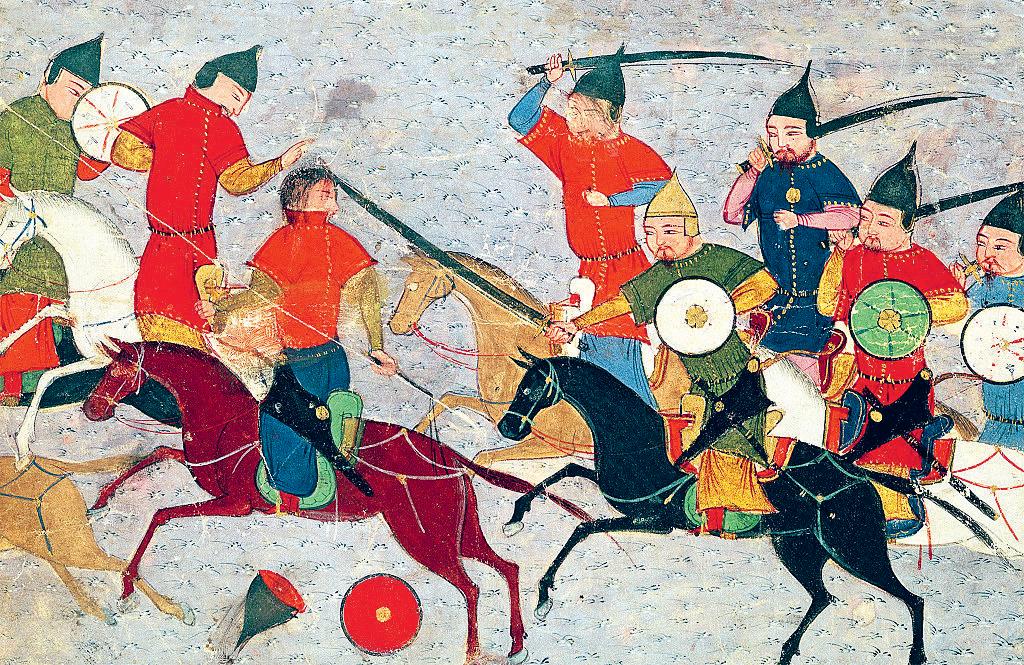
That’s exactly what Pederson and Hessl think.
Grass or no grass, Genghis Khan was a brilliant and brutal military planner who demanded toughness, dedication and loyalty from all his people. Soldiers who performed well in battle rose through the ranks. Cowards were killed. Each unit of ten men had a leader who reported up to the next level. If one soldier deserted, his unit of ten were executed. You can understand why people never disobeyed.
The Mongols were ruthless, but they were also open to new ways of thinking. They promoted people when they did a good job, not because they were from powerful families or even because of what country they were born
Above: the Mongol army does battle with the Khwarezmian army.







1,000 miles
in. The Mongol Empire was one of the most ethnically diverse in history, and this policy of promoting the talented meant people of many cultures were included in government. Of course there was just one exception. Genghis Khan and his family were always in charge.
The Mongols created an international postal system. They also did research to improve farming. Careful planning in military councils (called kurultai) and excellent spying using speedy horses were the keys to Mongol military success.
Whenever Genghis Khan faced an enemy city, he gave them a simple choice: surrender or die. As you can imagine, he was a man of his word. By 1215 the Mongols had
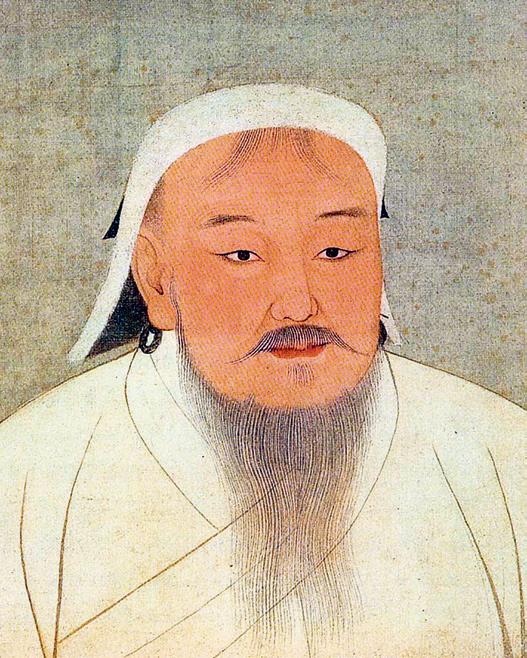
Genghis Khan and his children and grandchildren created the Mongol Empire. It was the largest empire composed of one land area that the world has ever seen.
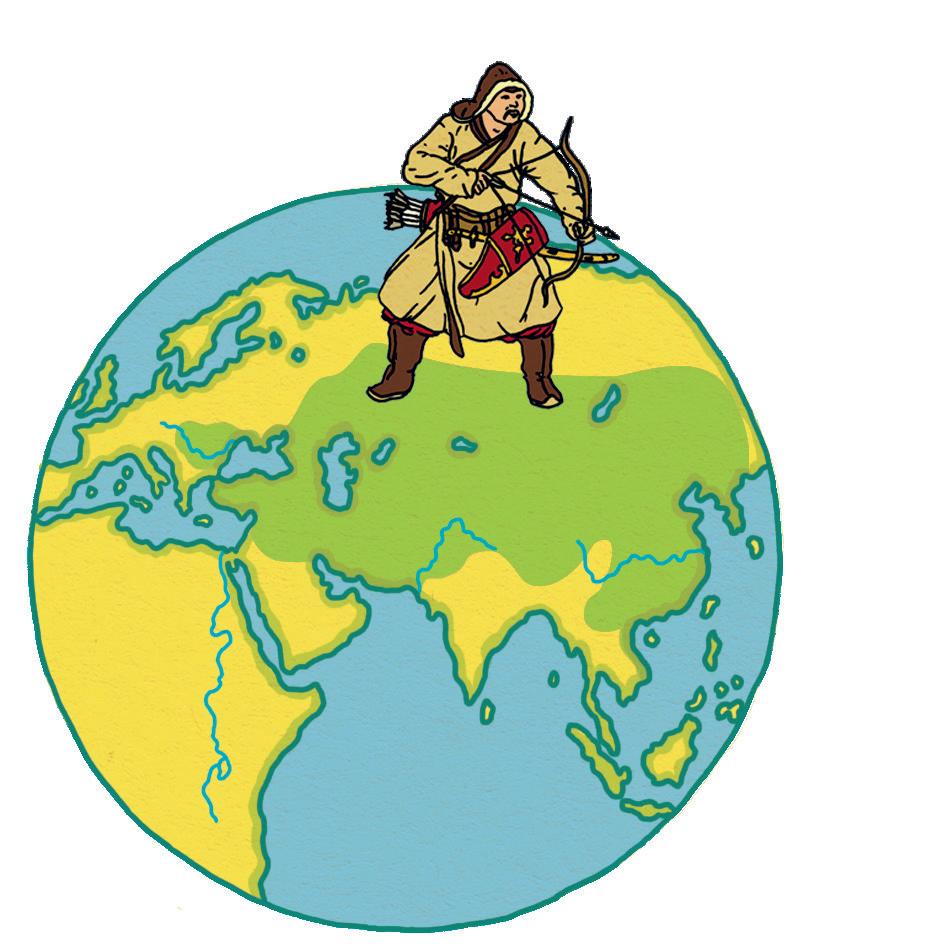


Battle of Yamen (1279) Genghis Khan’s grandson Kublai defeats the Song dynasty.
besieged and sacked the Jin Chinese capital at Yanjing (now Beijing). Genghis Khan then headed west, where his forces split into two and conquered areas that are now Georgia and parts of southern Ukraine.
On their way back to Mongolia they defeated a Russian army led by six princes. As was the Mongol custom, the defeated princes were crushed to death under the weight of a banqueting platform while the Mongol generals ate their victory feast on top.
Genghis Khan died in 1227 – no one knows how. Some say he fell off a horse. There is a legend that he was stabbed by a princess from northern China in revenge for the murder of so many of her country’s people.

THE MONGOL EMPIRE
Mongol Empire at the death of Genghis Khan, 1227 Mongol Empire at the death of Kublai Khan, 1294
Boundary of the Yuan
Dynasty under Kublai Khan
Genghis Khan’s children and grandchildren expanded the massive Mongol Empire deeper into central Asia, across Russia and all the way to Hungary. They also expanded farther into China. Even the Southern Song dynasty of China with its gunpowder weapons could not hold out for ever. It was one of Genghis Khan’s grandsons, Kublai Khan, who eventually defeated them.
The Song’s last stand took place at the battle of Yamen in 1279, just outside what is now Hong Kong. When a loyal court official saw that the Song fleet had been destroyed, he knew what he had to do. Grabbing the nine-year-old Song emperor, Zhao Bing, he lifted the boy up off his feet and jumped from a cliff to their deaths in the sea below. :
Delhi Samarkand Baghdad Yanjing Kaesong MONGOLIA RUSSIA CASPIAN SEACongratulations to reader Reuben Colton for creating this epic book poster…
My teacher, Miss O’Sullivan, set us a task to create an exciting advert all about something that we enjoy and love. I chose Britannica’s EncyclopediaInfographica as it’s one of my newest books and I have recently finished reading it. I wanted to make my advert bright and eye-catching. I wanted to put the message across that knowledge is power. I used Photoshop to bring this advert to life. I wanted to make it look like the information was literally jumping out of the book! I’m really happy with the way it has turned out.
Reuben Colton, age 11
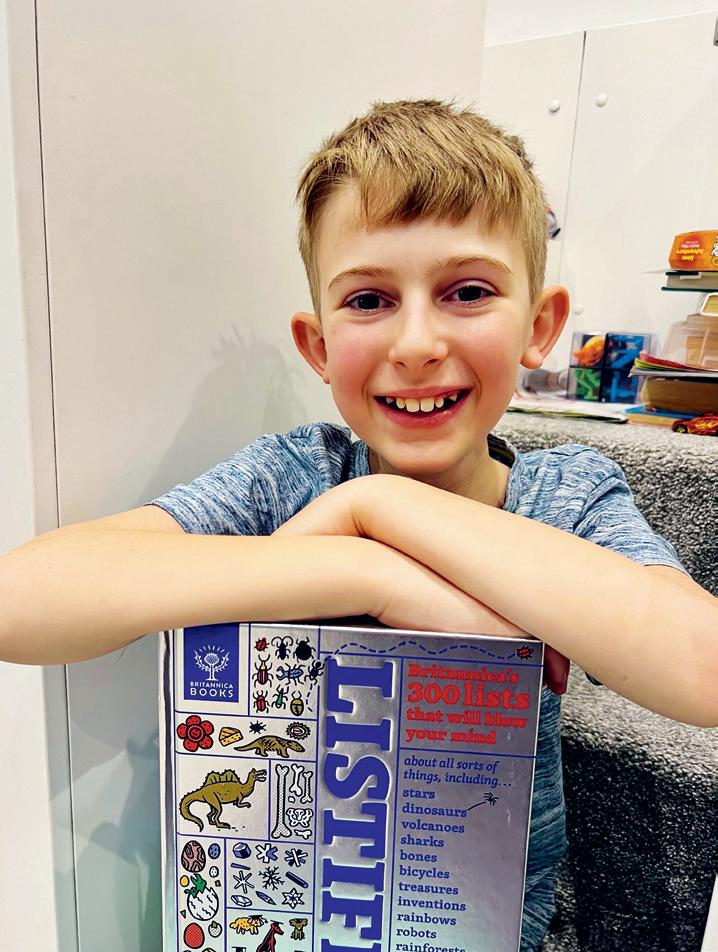
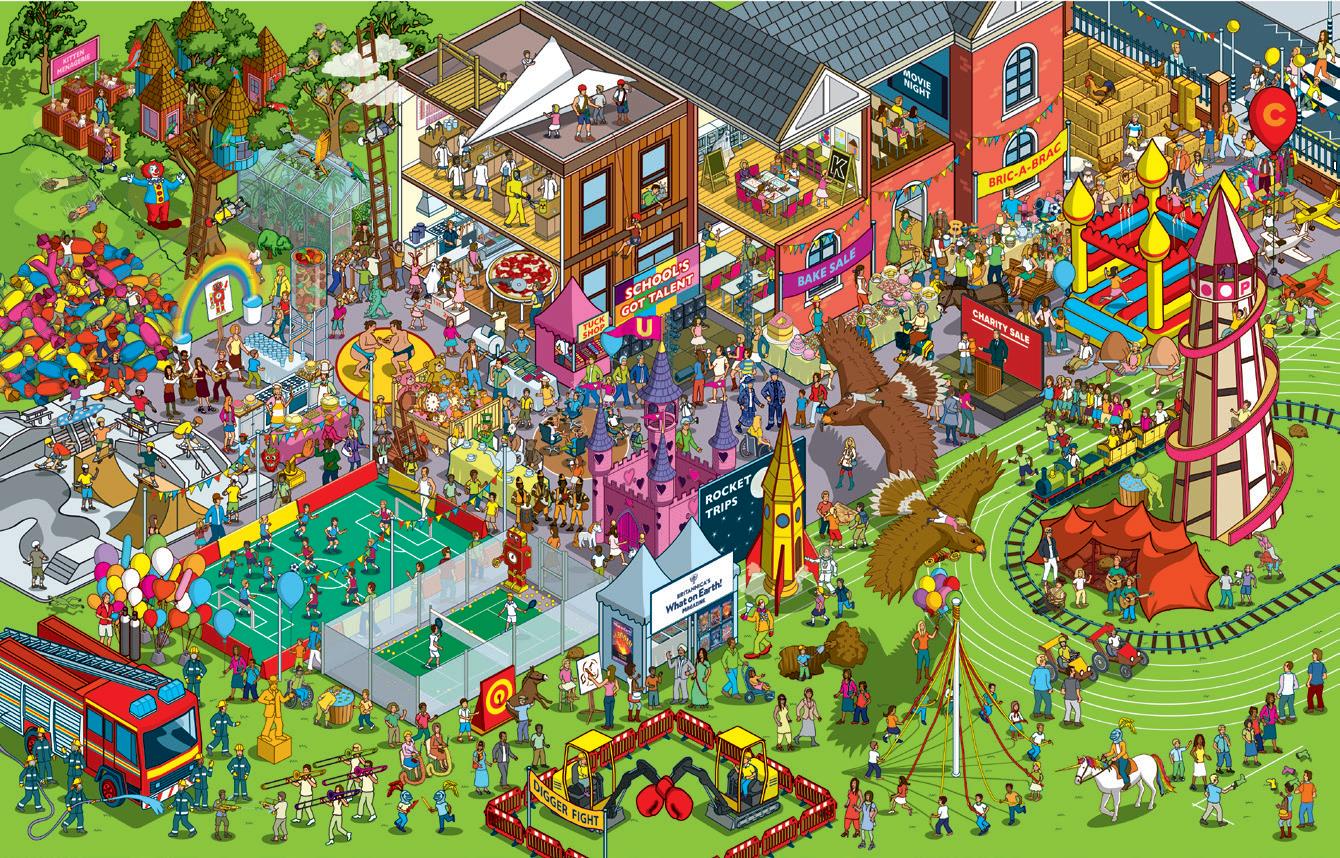
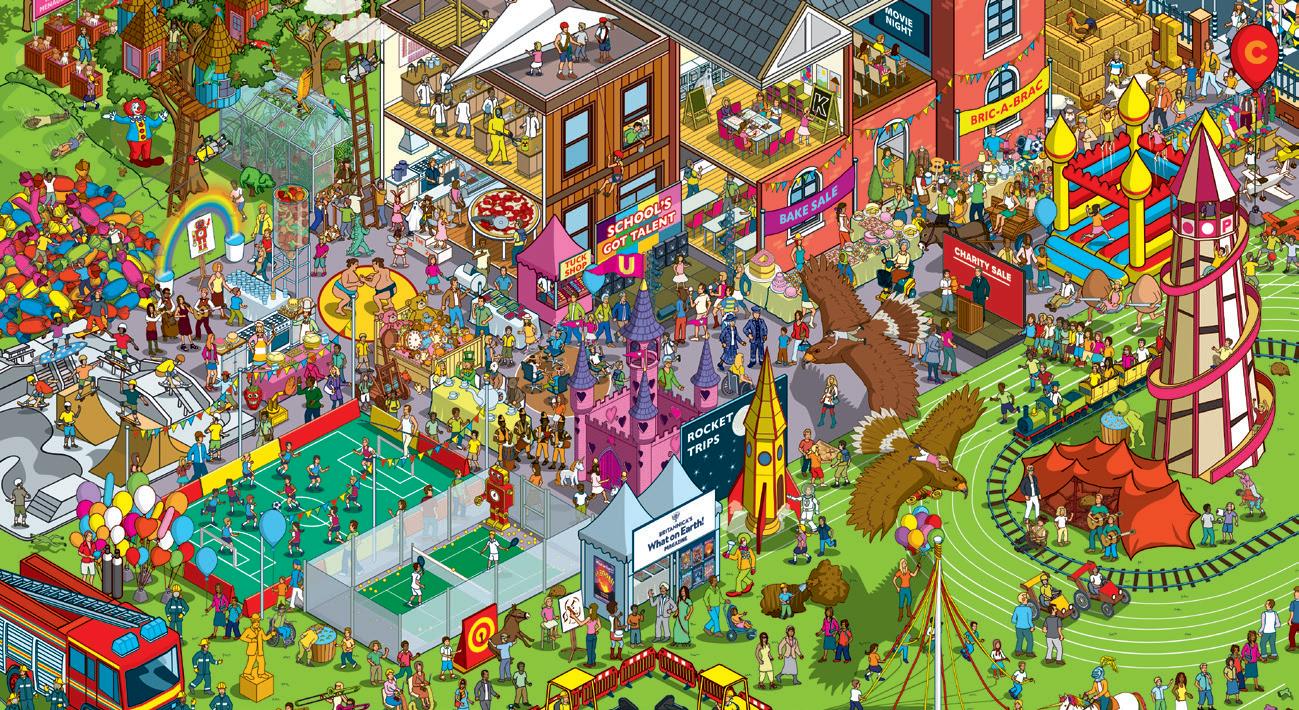



If your photo, drawing, letter or favourite fact is featured in a future issue of What on Earth! Magazine, you will win a copy of the brilliantly bizarre Science FACTopia!

If a golf ball didn’t have dimples, it would travel only half the distance. The dimples allow air to flow in a way that minimises the drag, or the force acting against the ball, letting it travel further.

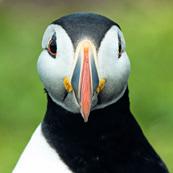




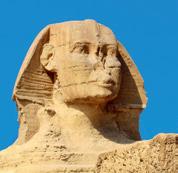
BRITANNICA’S
MAGAZINE
Published by
What on Earth Magazines Ltd, The Black Barn, Wickhurst Farm, Leigh, Tonbridge, Kent, TN11 8PS
Editor-in-Chief
Andrew Pettie
Editor
Alison Eldridge
Art & Design Director
Mark Hickling
Senior Designer & Illustrator Susanna Hickling
Production
Sarah Epton
Contributors
Andy Smith (including cover), Paige Towler, Andrés Lozano, Julie Beer, Rose Davidson, Susanna Hickling, Valentina D’Efilippo, Conrad Quilty-Harper, May, Dr Nick Crumpton, Adrienne Barman, Rod Hunt, Eva-Maria Sadowski, Sarah Darwin, Dan Knight
With thanks to Andy Forshaw, Natalie Bellos, Helen Thewlis and the whole team at What on Earth Publishing
Editorial Consultant
Nancy Feresten
Marketing Director
Luise Mulholland
Business Development
David Falzani
CEO, What on Earth Magazines
Christopher Lloyd
For Encyclopaedia Britannica
Mary McCudden, Director, Middle School and Elementary Products Printing and distribution Warners Midlands PLC, The Maltings, Manor Lane, Bourne, Lincolnshire, PE10 9PH
Editorial enquiries editor@whatonearth.co.uk
Subscriptions
01778 392479
whatonearth.co.uk
Picture credits
Selected library images from: Getty Images; Shutterstock; Alamy; iStock; NASA. What on Earth: Comedy Wildlife Photography Awards/ Tzahi Finkelstein, Dikla Gabriely; Sony World Photography Awards/ Ron Ratner, Liam Man; Eureka: ESO/ M Kornmesser; Renato Gaiga; Schmidt Ocean Institute.
Copyright
2024 What on Earth Magazines Ltd.
All rights reserved. No part of this magazine may be reproduced or transmitted in any form, including photocopying, without permission in writing from the publishers.
